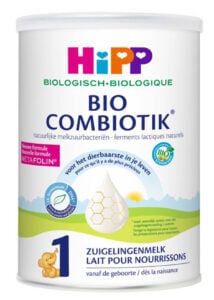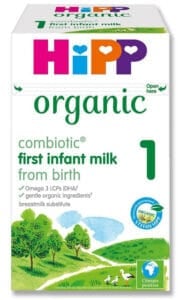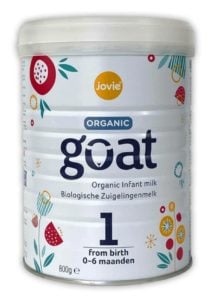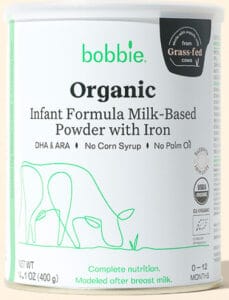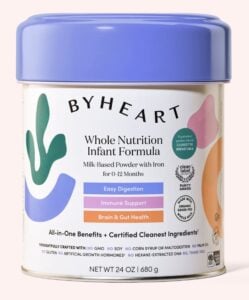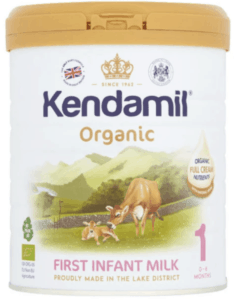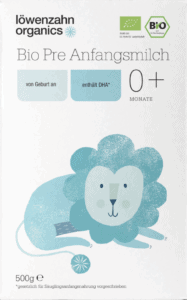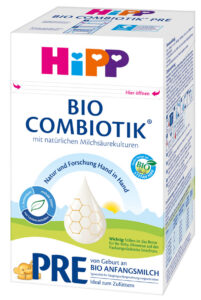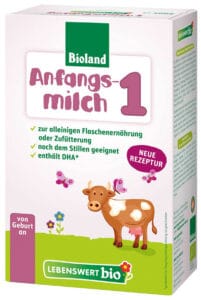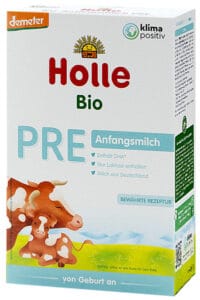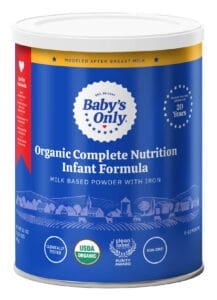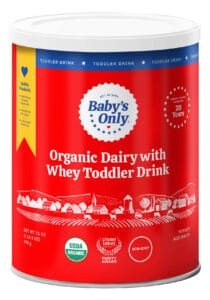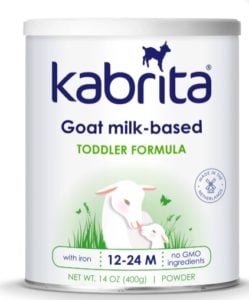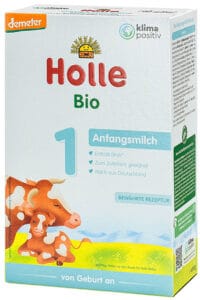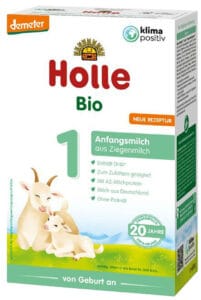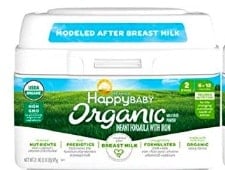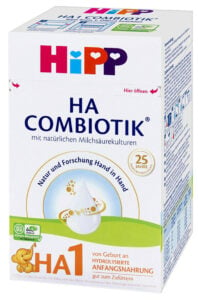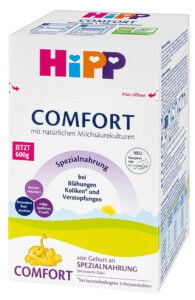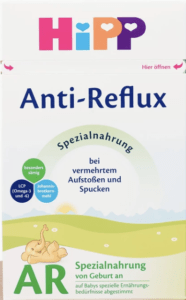Health
Best Organic Baby Formulas (2024 Guide)

This post may contain affiliate links. As an Amazon Associate, I earn from qualifying purchases. Please read my disclosure.
This in-depth, parent-friendly guide will help you find and buy the best organic baby formula. You will learn what you should consider when choosing a formula, what ingredients to avoid in formula, and where you can reliably purchase the best organic formula for your baby. This guide is updated monthly to ensure that all of the information below is recent and accurate!
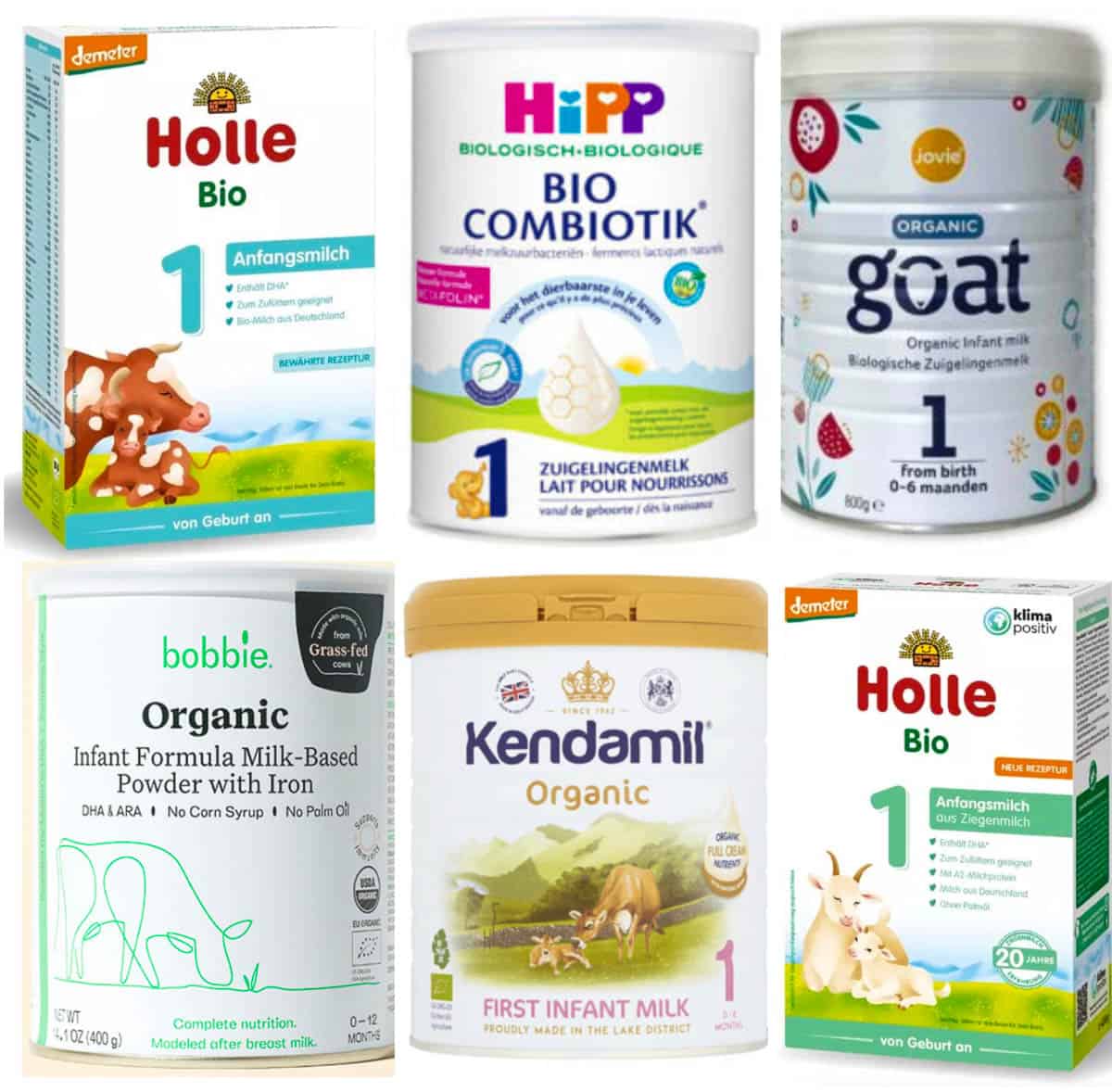

Click here to jump to the 11 best organic baby formulas!
A Note On Breastfeeding Vs. Formula Feeding
We’ve all heard the advice: “Breast is best.” For a few moms, that advice is easy to follow. Unfortunately for many moms, it’s not.
The truth is, breastfeeding is HARD.
Not hard as in “oh this is hard, I don’t feel like doing it,” but hard as in: My baby won’t latch; I have low milk supply; My nipples are sore/bleeding/blistered; I have no place to pump at work; I have mastitis; I’ve seen dozens of lactation consultants, and I’m still having problems.
And then there are all of the moms who can’t breastfeed because of a medical reason, or because they are adoptive parents (or had their children via a surrogate).
That’s all to say – if you love breastfeeding, great. But if you need to supplement or switch to formula, that’s more than okay, too!
Many moms feel guilt over weaning early or not being able to breastfeed as much as they’d like. But honestly, the most important thing is the love you give to your baby, and that you and your baby are happy and healthy. Breast isn’t best; FED is best.
For me, nursing my daughter was one of the most physically and emotionally challenging parts of new motherhood. Many of the early days ended in tears. When I weaned her after 8 months of emotionally taxing nursing and pumping, I needed to select a baby formula, and this guide is a result of the research I conducted (see my disclaimer, credentials, & methodology for details).
A Disclaimer & Our Methodology
As a board certified health coach and certified nutritionist, I support products and ingredients that are rooted in science and are evidence-based. Using my background in nutrition, along with extensive research (see below for details), consultations with experts, and my own personal experience giving my two kids formula, I was able to arrive at this list of the best and healthiest formula for babies in this guide. This post has also been medically reviewed and fact checked by Katie Drakeford, MA, RD, CSP, LD, CLC (see my about page for more info about Katie).
My baby formula recommendations are based on:
- Over 200 hours of extensive research
- Speaking with thousands of parents on what has worked for their children (along with personal experience with my own two kids)
- Reviewing the manufacturer’s claims and ingredients list, stages, and varieties of over 65 different formula brands
- Speaking with doctors and pediatricians
- Reviewing countless articles and peer-reviewed studies
Though I may receive a commission (at no extra expense to you) if you purchase through some of the affiliate links provided, I only recommend products I’ve researched, evaluated, consulted experts on, and would feel comfortable giving to my own two children.
As always, I only share products that are the highest quality and that can help you and your family the most. By purchasing any of these products from the links below, you help keep this blog running, so thanks for your support!
Keep in mind that every baby & situation is different, so when it comes to choosing a baby formula, please consult with your pediatrician first before starting or switching to a new formula. My recommendations are not a substitute for professional medical advice, diagnosis, or treatment.
What Is Organic Baby Formula?
Organic baby formula is defined as being made with at least 95% organic ingredients. This means that 95% of the ingredients in the formula have to adhere to organic standards, (source), which include:
- No GMOs (Genetically Modified Organisms)
- No growth hormones or steroids
- No antibiotics (or used extremely rarely – only when an animal is extremely sick and no other options will resolve the issue)
- No artificial colors or flavors
- All animals are fed an organic diet
- No synthetic or artificial preservatives
- No pesticides or insecticides (note: natural pesticides and organic insecticides are allowed)
In Europe, these standards are more heavily regulated than in the US, and additional considerations are added, such as:
- No sugar or syrup solids (Learn More: Sugar And Corn Syrup In Baby Formula).
- Requires at least 30% of calories from lactose (the naturally occurring carbohydrate in milk)
- No synthetic nutrients extracted with chemical solvents
A note on organic labeling: Certified organic does not mean the same thing as “made with organic ingredients.” If a package has the label “made with organic ingredients” it means that only 70% of the ingredients are organic, not 95%. (source).
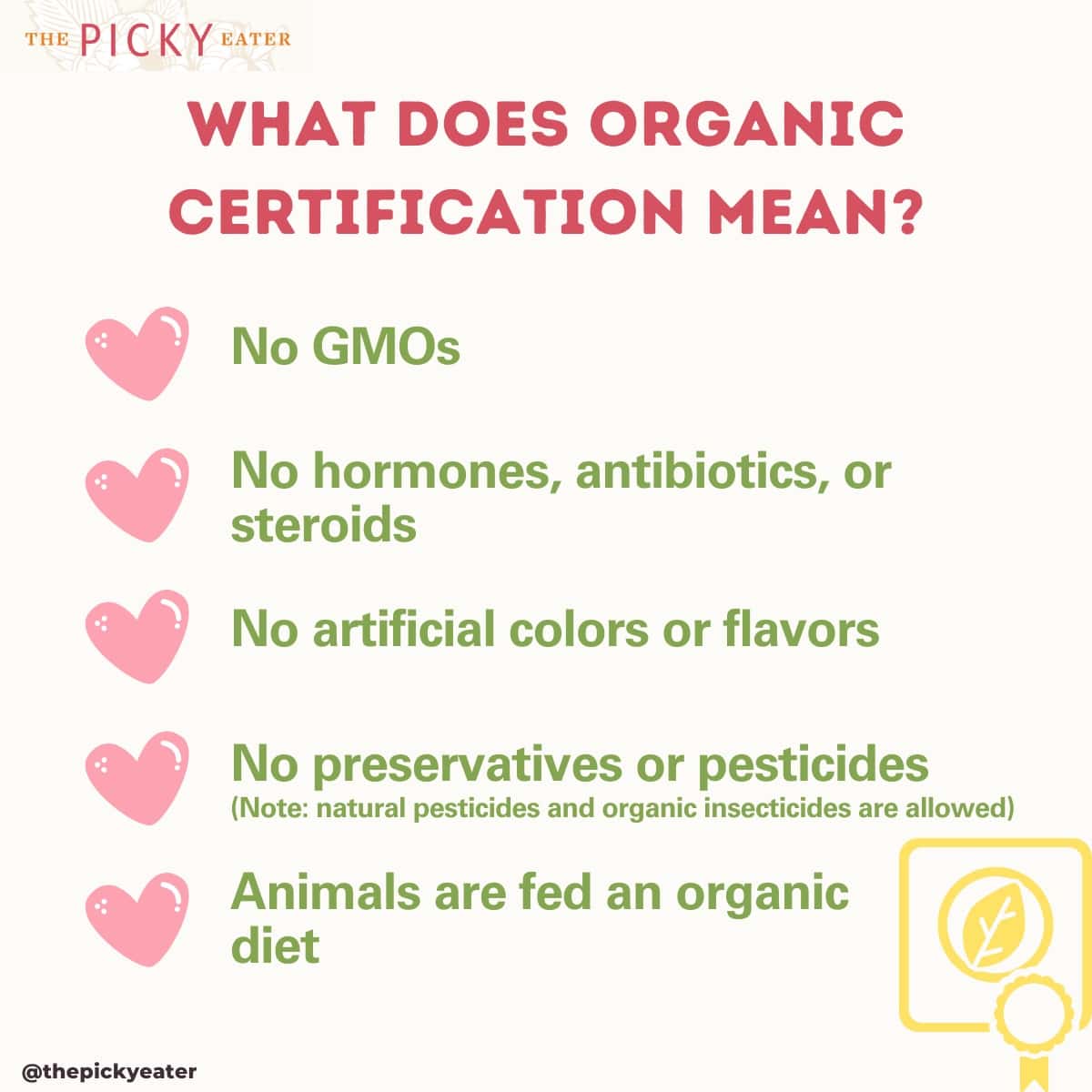

Is Organic Baby Formula Better For Your Baby?
The benefits of buying organic baby formula are similar to buying organic foods in general. By buying organic milk formula, you can guarantee that your baby’s formula is made without growth hormones, genetically modified ingredients, non-organic pesticides, herbicides, fungicides, antibiotics, etc.
Additionally, most of these formulas also have the added plus of not using processed or problematic ingredients like syrup solids, etc. that aren’t beneficial for your baby, making them some of the cleanest baby formulas.
Many doctors will say that there isn’t enough research on the topic of whether natural infant organic formula provides your baby with more clear, long-term health advantages than conventional formula does. It’s also important to note that most natural baby formulas tend to be more expensive.
That said, if you can afford it, any of these potential added benefits might be worth it to you if the cost fits your budget.
Luckily, there are some budget-friendly organic formula options available (see our quick picks below). And if you can’t afford any organic formula brands, I recommend choosing a formula that meets our criteria for choosing the best formula overall. That way, you may still be able to choose a budget-friendly, non-organic formula for babies that does not include syrup solids, or other problematic ingredients.
Quick Picks: Best Organic Baby Formula
Here is our “at a glance” view of the best organic formula for babies for a variety of different needs. Looking for the cleanest baby formula? A hypoallergenic formula? The safest baby formula? The best overall? We have you covered.
Further down in this guide, you will find a detailed list of the top 11 best organic baby formulas, a few runner-ups (good formula brands that didn’t make our top list), and why we love each of those options.
What Are The Different Types Of Baby Formula?
- Organic Cow’s Milk-Based Formula: Most of this type of infant formula found at the grocery store is made from cow’s milk, and contains at least 95 percent organic ingredients. You can also be assured that the product is free from preservatives, toxins, artificial colors, and artificial flavors.
- Non-Organic Cow’s Milk: Regular cow’s milk formula is still made from cow’s milk (hence the name), yet it might contain hormones, chemicals, and pesticides since it is not organic.
- Organic Goat’s Milk Baby Formula: Goat milk is very similar to dairy-based formulas in terms of nutrients. But, because it’s made from goat milk which contains solely the A2 milk protein (vs. both A1 and A2 for most cow’s milk), it may be easier for some babies to digest who are intolerant to cow’s milk. Organic goat’s milk is non-GMO and free from preservatives, toxins, etc. Learn more: Goat Milk Formula vs. Cow Milk Formula and Benefits Of Goat Milk Formula.
- Non-Organic Goat’s Milk: Regular goat’s milk formula is more common than its organic counterpart. However, it is a popular option because all goat milk still has the A2 vs. A1 milk protein, and can be easier to digest.
- Hydrolyzed Protein Formula (Hypoallergenic Formula): There are two types of hydrolyzed formulas – there are partially hydrolyzed versions which have partially broken down milk proteins, and extensively hydrolyzed versions which have completely broken down milk proteins. These broken down proteins are easier to digest, and may help babies with a milk protein allergy or who just have more sensitive tummies.
- A2 Milk: A2 milk is an alternative to regular cow’s milk that is often easier for babies to digest, because it’s more similar to human breast milk. A2 milk can come from goats, or from a small population of cows that happen to produce A2 vs. A1 milk. (Learn More: Best A2 Baby Formula).
- Soy-Based: These formulas don’t contain any milk and use soy protein as the base. They are a non-dairy formula option. Note: You should always consult your pediatrician before considering a soy formula for your child, due to research that shows it may not be suitable for all babies.
- Toddler Formula: While most toddlers don’t need formula, toddler milk formula is designed to be consumed after a child’s first year of life. Essentially, it is a kind of transition formula and can be used to supplement a picky eater’s diet with critical nutrients.
- Plant-Based Baby Formula: Plant-based formula is made without using animal products. Basically, you can think of it as being a dairy-free baby formula or vegan formula option. Formulas like Else and Baby’s Only Pea Protein are common vegan formulas available in the US. See this guide for the best dairy-free and vegan baby formula.
- Powder Vs. Liquid: Most natural baby formula comes in a powdered option, where you have to mix with water before serving. Some brands of formulas will also have a liquid option, which means the formula is already pre-mixed and pre-made so you can feed it to your baby immediately. Liquid formulas are also known as “ready-to-feed” formulas. There are some organic ready-made formula options, but they may have more stabilizers than powdered versions to keep them shelf-stable.
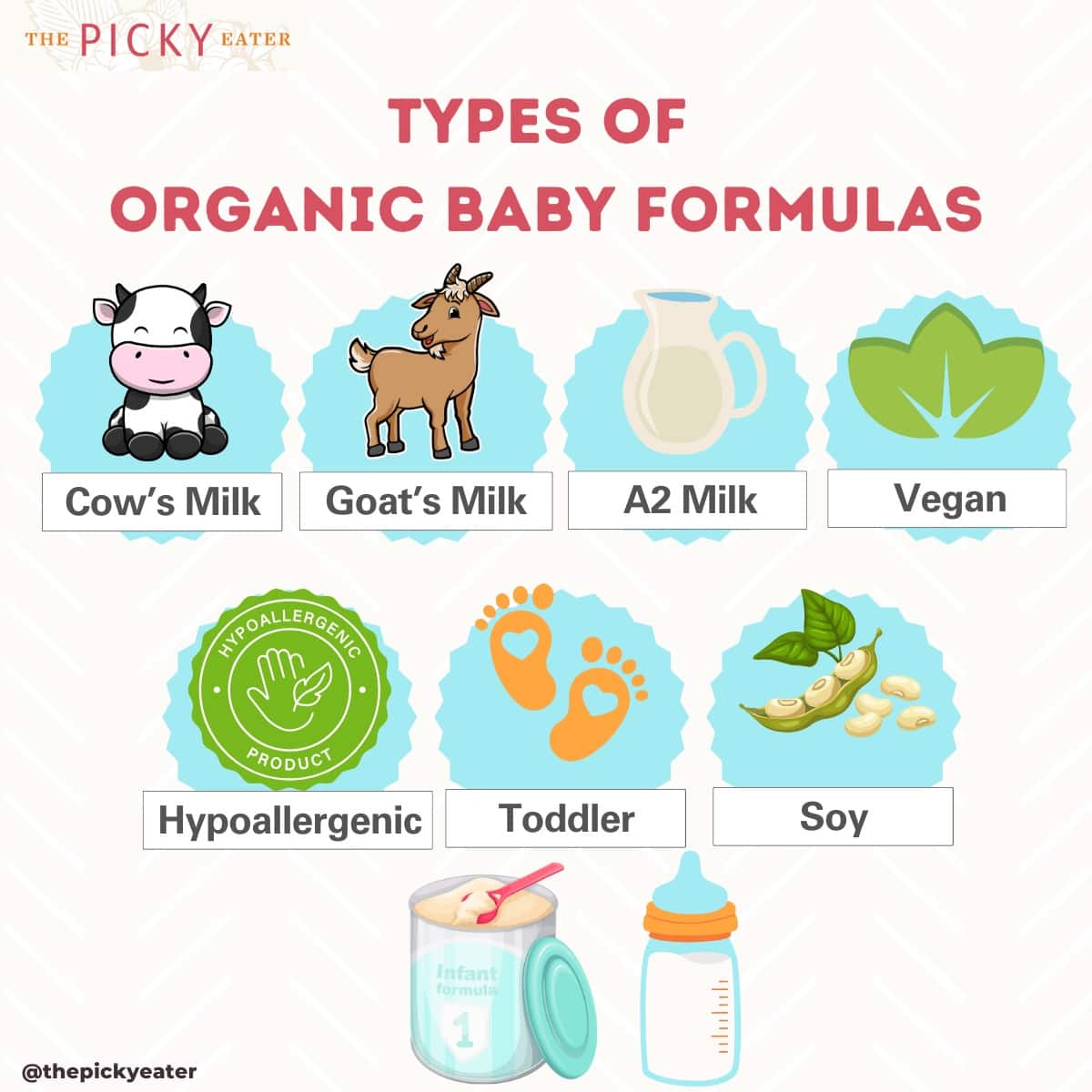

European Vs. American Baby Formula
When I was choosing an all-natural baby formula for my kids, I chose a European Organic Baby Formula instead of purchasing one from the US. What’s the difference between European and US baby formula?
All US-based formulas are regulated by the FDA and organic milk-based formula brands earn a certification from the USDA on top of being regulated by the FDA. The FDA is responsible for ensuring formulas meet infant nutrition requirements, while the USDA Organic certification means that the baby formula is adhering to the USDA guidelines mentioned above (e.g. no hormones, antibiotics, etc.). (source).
All European Formulas are regulated by the European Commission, which also certifies formulas as organic. Additionally, Europe has designations that are “beyond organic” like “Demeter” or “Bioland”. (source).
Demeter essentially means biodynamic farming on top of organic farming. It is focused on creating the most humane conditions for the cows and ensuring the farm “gives back” to the environment in their practices. “Bioland” means that the entire farm is 100% organic and there are no nonorganic products produced on that farm. Bioland is more strict than organic, but not as strict as Demeter. Holle is the only European formula that is Demeter certified, and Lebenswert is Bioland certified. (Want to learn more about Demeter standards? See our guide to Demeter standards in Europe here.)
It’s worth noting that the EU and USDA are aligned on a few things when it comes to what gets the official “Organic” label:
- Both US and European formulas can only be considered organic if 95% or more of the ingredients are organic.
- Both US and European organic formulas will not come from cows that have been given artificial growth hormones.
- Both US and European formulas will contain the essential nutrients to support a baby’s growth and development.
So Why Choose European Formulas? Overall, Europe has higher standards and has more options for high-quality organic and natural formula for babies. Some American brands are similar to European brands in quality and ingredients, and we have included those options in this guide as well.
When it comes to regulation, anecdotally I have heard and seen that Europe regulates organic standards much more strictly than the US does. Not only do European organic baby formulas have to meet the 95%+ ingredients standard, the EU also requires more transparency and has stricter regulations when it comes to detecting trace amounts of any toxic substances in natural baby formula. (Learn More: Why Parents Love European Baby Formulas).
Historically, most formulas, especially those produced in the United States, have certain ingredients that aren’t very healthy for your baby (like glucose syrup solids and some stabilizers and preservatives). This is why it is great that there are so many higher-quality and healthy baby formula options available to parents today.
Note: Translated Nutritional Information And Preparation Instructions For European Formulas
When you buy European formulas, especially the Dutch or German formulas, their labels may not always come with an English translation. To help map European formula nutrition onto US standards, we have partnered with Bottles & Burps to provide you with detailed guides for all of the non-UK-based European formulas! (Note: Get 20% off any single pack using the code PICKYEATER20 when shopping at Bottles and Burps! Just enter it manually in the checkout process!)
See below for translated nutritional labels, ingredients, and preparation instructions so it’s easy to compare to any US-based formulas. You can also learn more about European formulas here: Are European Formulas Safe To Use?
Baby Formula Stages
European baby formula is designed in stages – so that the different stages of formula correspond to the different ages of your baby. Just as breast milk changes to meet the changing needs of your baby, the different stages of formula change to meet these evolving needs as well. Each stage is formulated to meet the nutritional requirements of a specific age and stage of your baby’s development.
US baby formula, on the other hand, is more commonly found in a one-size-fits-all model. That is, there is one stage of formula for all babies aged 0-12 months (also known as “infant formula”) followed by one separate stage for babies aged 1+ (“toddler formula”).
Here are what the different stages of European baby formula mean:
Stage PRE/1: This stage is suitable to give to your baby from birth. These formulas tend to use lactose as the main source of carbohydrates and are very gentle and easy to digest. They will contain less iron than do the later stages since your baby’s iron stores remain intact until about 6 months of age. Stage PRE/1 is for babies 0-6 months old. Stage PRE is typically a formula for newborns through 3 months of age, but can be used for up to 6 months. PRE is also slightly less filling than Stage 1, so you can adjust based on your baby’s appetite between these two stages during the first 6 months of life.
Stage 2: For formulas that only have 2 stages, stage 2 is for 6-12 months of life. For formulas that have 3 stages, stage 2 will typically be for 6-10 months of life. Stage 2 has more iron, and a slightly different mix of vitamins and minerals to adjust to your baby’s growing needs.
Stage 3: Typically used for 10-12 months of life, and sometimes can be used into toddlerhood. It is made specifically to supplement your baby’s diet of solid foods which should be increasing around 11-12 months of life.
All Ages Formula: Some formulas, typically US formulas, don’t come in stages, which means that they are all-ages formulas (also known as “infant formula”) and can be used for 0-12 months of life.
Ideal Baby Formula Ingredients
Here’s our ideal list of baby formula ingredients and criteria, and how we made our picks for the best formula for babies in this guide.
✅ Certified Organic (either USDA-certified organic or EU-certified organic).
✅ Meets nutritional standards for babies (in the US or the EU) and includes key vitamins and minerals for development
✅ No sugar, sucrose, or syrup solids (you want a formula without added sugar. Ideally, lactose should be the only carbohydrate) (Source).
✅ Whey to casein ratio that matches mature breast milk (60:40 whey to casein ratio)
✅ Includes Omega 3 Fats (DHA, ALA) and Omega 6 fatty acids (ARA, LA) (Source).
✅ Includes prebiotics and probiotics (Learn More: Prebiotics For Kids). (Source).
✅ Gluten-free and soy-free (except for organic soybean oil and organic soy lecithin, which are ok)
✅ Palm oil free (or uses palmitic acid, or sustainable palm oil. Learn more: Palm Oil In Baby Formula)
✅ No carrageenan
✅ No hexane extracted ingredients if possible (DHA specifically), or no hexane detected post-extraction
✅ No maltodextrin
✅ Mixes easily, reviews state that most babies can tolerate it well
✅ Suits your budget
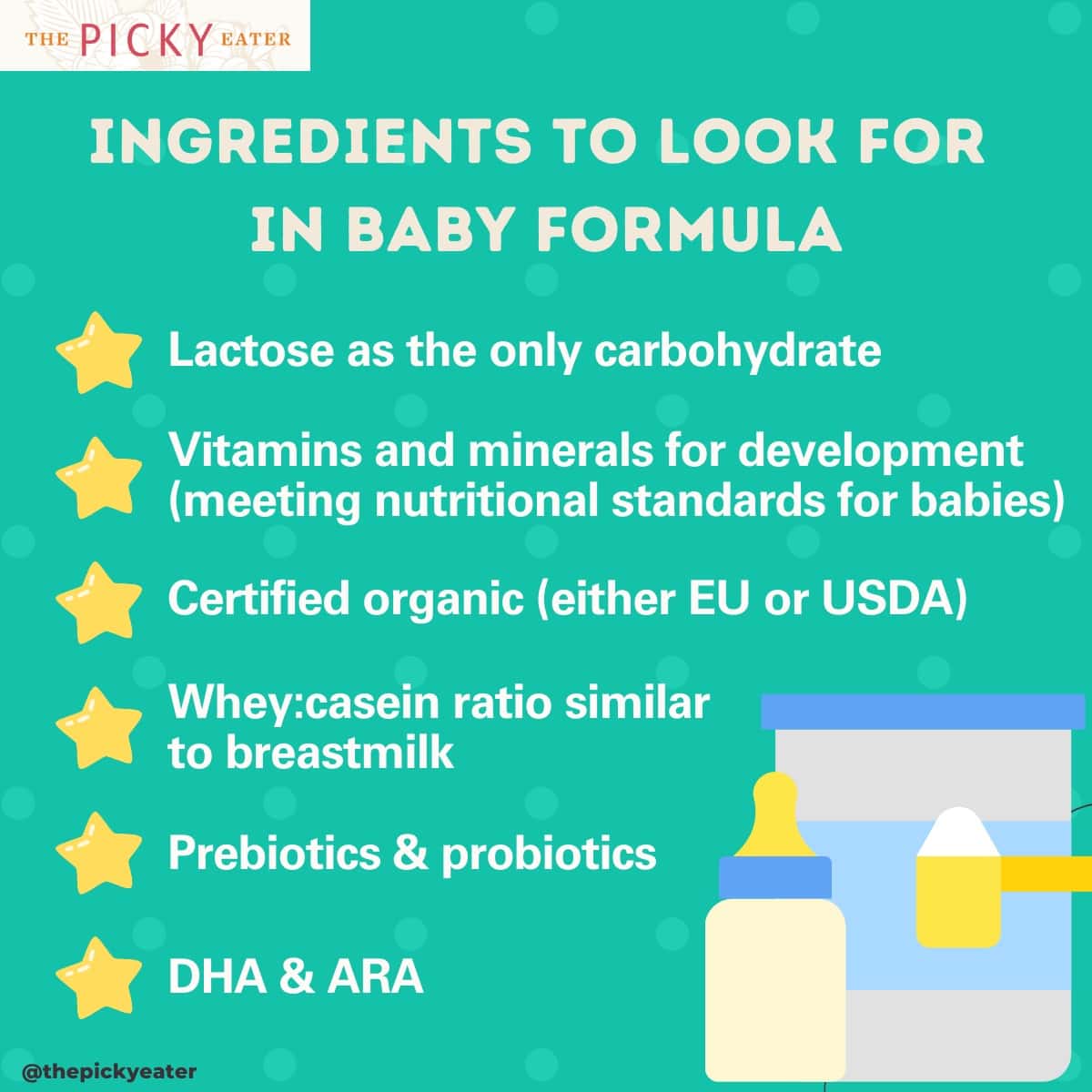

Ingredients To Avoid In Baby Formula
The US has a much larger range of standards for organic baby formula, which means that even the best organic formulas can have lower-quality ingredients. Below are the ingredients that shouldn’t appear in organic baby formula – as outlined by the National Organic Standards Board. Many of these ingredients are banned in the European Union, which is the gold standard for what’s considered organic. Look for formulas that do not contain these ingredients:
❌ Processed Refined Sugars (Syrup, Syrup Solids): Corn syrup solids (glucose syrup solids), maltodextrin (a partially hydrolyzed starch derived from corn, rice, or potatoes), sugar, or brown rice syrup. Manufacturers use these because they are cheaper than lactose (which is what should be in formula). (Source).
❌ GMOs: Genetically Modified Organisms (GMO) ingredients, while recognized as safe by the FDA (source), often need a large amount of pesticides when they’re being grown, which not only has an adverse effect on the environment, but also comes with the risk of trace amounts ending up in the foods (and formulas) produced using GMO ingredients (Source 1, Source 2).
❌ Oils extracted using hexane (DHA, ARA): DHA and ARA are important to have in baby formula, because they are essential fatty acids that are important for both brain development and eye development. However, specific types of DHA and ARA – C. Cohnii oil (DHA) and M. Alpina oil (ARA) are processed using hexane (a neurotoxic petroleum-based solvent). Other forms of DHA and ARA, such as DHA and ARA that are extracted from algae fungus, can be added to formulas that do not require hexane for extraction. While the hexane is removed from the formula after processing and is non-detectable in European Formulas (see my detailed section on hexane at the end of this post). It’s also worth noting that any oils that are listed as “organic” on EU formula labels cannot use hexane for extraction. (Source).
❌ Carrageenan: Is typically added as a stabilizer to ready-to-feed formulas in the US; it is not allowed in the EU and has been linked to intestinal inflammation. (Source).
❌ Synthetic Nutrients Extracted Using Chemical Solvents: This includes lutein, lycopene, nucleotides, taurine, l-carnitine, and l-methionine that are extracted in this manner. Some of these nutrients are not allowed in EU formulas, some of them (like lutein) are beneficial to babies, but they ideally are extracted not using hexane.
❌ Palm Oil: to mirror the levels of palmitic acid, which is found in breast milk, some manufacturers add palm oil. The problem is that palm oil in formula does not act the same way that palmitic acid does in the baby’s gut. Palm oil reacts with calcium, and causes the formation of “soaps” in the baby’s intestines (which can cause digestive issues). Palm oil is in most formulas (EU & US), but more manufacturers are now making formulas without it. (Source).
❌ Soy: Soy protein (and soy formula) are problematic for infants because of their phytoestrogen content (Source: Check out this study about soy).
Unfortunately, nearly all baby formulas sold in the US have one or more of these ingredients to avoid.
So what’s a parent to do?
Stick to the high-quality European formulas or US formulas like Bobbie which mimic European standards. The EU has some of the best organic baby formula options, and HiPP, Holle, and Lebenswert, all produce high-quality formulas with the best ingredients. For this reason, all of these are the best European formulas for babies.


How To Choose The Best Baby Formula
While all of this information might seem overwhelming, at the very least, I recommend following these guidelines when choosing the best formula for your baby:
- Organic if possible, and if you can’t afford organic, try to find a non-GMO or at least a formula with no glucose, corn, or other syrup solids.
- Helpful nutrients – added DHA, ARA for brain development, prebiotics & probiotics for immune and gut health.
- Strong and reliable reviews from other parents.
- Pediatrician approval – your pediatrician knows your baby and has experience with many of these formulas, so they should be able to help you figure out which of these formulas will suit your baby the best!
This list includes both European and US formulas. Go to this guide for the best baby formula brands made in the US if you’re specifically interested in US-made baby formulas!
Below, I have summarized my research to help answer the question: what is the best organic baby formula available today? Later in the post, I cover what to look for in choosing a baby formula, the main ingredients to avoid, an analysis of each top formula, a detailed chart that ranks all of the organic formulas available, and a list of a few reliable places to buy formulas online.
The 11 Best Organic Baby Formulas
While there is no perfect formula, the baby formulas below are considerably better than the rest. Read on to see the best organic formula for infants and our top picks based on your baby’s individual needs.
HiPP Dutch – Best Overall
Why I love it: Of all the formulas, this is the best overall organic baby formula. It has a whey-to-casein ratio that mimics breast milk, uses vegetable oils for fat, contains prebiotics and probiotics, and contains DHA/ARA. It’s also free of GMO ingredients, added sugars, starch, soy, and synthetic nutrients and preservatives. It also comes in an easy-to-dispense, airtight container! There aren’t many reasons not to consider this the best natural baby formula! Because of its closeness to breast milk, it can be one of the best formulas to supplement breastfeeding. HiPP has lots of different formulas, but HiPP Dutch is the best HiPP formula you can find. See translated nutrition facts, ingredient info and detailed instructions for preparation here.
Keep in mind: If you are concerned about hexane extraction, HiPP organic baby formula uses this method to retrieve the DHA and ARA in their formula. They claim, however, that 100% of the hexane is removed after extraction and is not detectable in their formulas. Given that this European brand follows guidelines that are much more stringent than those in the US, I’m inclined to believe them.
Price: $48.99 for a single pack. (Save if you buy in bulk: $42.99 each for a 24 pack).
What Customers Say: “My grandson is doing so well on this formula. My daughter loves it. Baby is not spitting up this formula like the Gerber brand. I feel so good about the baby drinking this in his bottles.” – Barbara R.
Whey-to-casein ratio that mimics breast milk
Contains prebiotics & probiotics
No added sugars, no starch, no maltodextrin
Easy to dispense from container
Does use hexane to extract DHA & ARA, but hexane 100% removed and is undetectable in the formula
HiPP UK Stage 1 – Best Value
Why I love it: HiPP UK is also quite similar to HiPP Dutch. At $0.048/gram, it is the most budget-friendly healthy organic infant formula option.
Keep in mind: The main difference between HiPP UK and HiPP Dutch (besides the price) is that it contains no probiotics, only prebiotics. Like HiPP Germany, it also has a container that’s harder to dispense from (foil bags vs. an airtight can).
Price: $42.99 for a single box. (Save if you buy in bulk: $36.99 each for a 24 pack).
What Customers Say: “I chose Hipp Organic UK because I’ve heard so much good things about it! My baby was on enfamil & it was the WORSE! So I was determined to find the best Formula for my baby! UK brands are by far the best for your baby. I chose the Milky Box because it’s reliable & safe. I have no worries when it comes the safety of my baby’s formula & the safety of my personal information. STRONGLY recommend Hipp Organic!” – Irene W.
Affordable organic infant formula
Doesn’t contain probiotics
Harder to dispense from box
Jovie Organic Goat – Best Goat Milk Formula for Babies and Toddlers
Why I love it: If you’re looking for the best goat milk infant formula, and a great alternative to cow’s milk, I’d recommend the European version of Jovie Goat. The ingredients are 100% organic, non-GMO, with added prebiotics and a whey-to-casein ratio that closely resembles that in breast milk, making it an incredibly healthy formula for babies. In addition, it’s made with organic whole A2 goat milk and lactose instead of skim milk for easy digestion. This best infant formula option contains no glucose syrup solids, no maltodextrin, no palm oil, no soy oil, and contains DHA & ARA. (Learn More: Jovie Formula Review).
Keep in mind: Jovie doesn’t contain probiotics, so you would have to supplement. It’s also not vegetarian, as it contains fish oil. Also, there is a US version of Jovie available, but it is not certified USDA organic because their whole goat milk powder is not USDA organic. The European version of Jovie does meet European organic standards.
Price: $62.99 for a single pack. (Save if you buy in bulk: $56.99 each for a 24 pack).
What Customers Say: “Great formula. My newborn was constipated on cows milk formula and became regular as soon as I switched her to this one. Smells great too.” – Karina R.
Made with A2 organic whole goat milk – easier to digest than cow’s milk
Doesn’t contain probiotics
Not vegetarian friendly (DHA is from fish oil)
On the more expensive side
Bobbie Organic Infant Formula – Best Organic Baby Formula Made in the US
Why I love it: Bobbie is the best organic infant formula made in the US, made with milk sourced from Organic Valley pasture raised cows. It is the best option if you’re looking for a US-made formula that is comparable to European formulas, as it’s the first Organic, European-Style Infant Formula that meets FDA requirements.
The only mom founded and led infant formula company in the U.S., Bobbie is made by parents for parents, who are looking for a nutritious and organic baby formula for their little ones. In fact, it is the cleanest formulas for babies manufactured in the US! This best American formula includes DHA and ARA – and does not use hexane to extract the DHA. They do use hexane to extract the ARA, but it is not detectable in their formula. Bobbie has a 60:40 whey-casein ratio, is modeled after breast milk, is non-GMO, free of added sugars, and has no synthetic nutrients or preservatives. It also happens to be palm oil and soy oil free (Learn More: Palm Oil In Baby Formula). And with their starter bundle, you can try Bobbie in a budget friendly way (2 cans for only $20 per can + free shipping!)
Keep in mind: Bobbie does not add prebiotics or probiotics to their formula. Personally, I prefer pre/probiotics added to formula mainly for convenience. If you want to supplement with prebiotics, I recommend BeginHealth prebiotics. (Learn more: Best Probiotics For Kids).
Price: $25.99 for a single can (at Target). $23.40 per can if you sign up for the monthly subscription on Bobbie’s website.
What Customers Say: “Thank you for providing such a great formula for our babies. My baby has been on Bobbie since she was born and has never had any other type of formula. Not once did she have a tummy ache from it. She always digested it well, and was always right on point in her nutrition per her pediatrician. Makes me sad to go, but we are officially on our last can and I’m so proud of our journey. Thank you.” – Julie
Designed to meet the most recent EU nutritional standards for critical ingredients like DHA and iron, while also meeting all FDA nutritional standards for infant formula.
USDA Organic grass fed infant formula
Designed to taste like breast milk
Organic lactose is the main carbohydrate
No corn syrup, no cane sugar, no maltodextrin
Non GMO, gluten free, no natural or artificial flavors or colors
60:40 whey casein ratio for easy digestion
Available for sale in the US (at Target) and online
Affordable and budget friendly
Doesn’t contain prebiotics
Doesn’t contain probiotics
ByHeart Organic Infant Formula – Best Whole Milk Formula Made in the US
Why I love it: Made with organic grass fed whole milk and non-GMO ingredients, this organic baby formula is a newer player in the American market. Because it is made with whole milk, this formula has less added vegetable oils than does Bobbie or other brands that are made with non-fat milk. Furthermore, ByHeart ran one of the largest successful clinical trials of a new formula company has already received the Clean Label Project Purity Award.
This formula has a whey-to-casein ratio that mimics breast milk as well as a patented protein blend that contains proteins, such as alpha-lac and lactoferrin, in the same ratios as breast milk. Though I am usually not a fan of synthetic ingredients, these two are known to be helpful in developing gut health (source). Lactose is the primary carbohydrate source and the formula contains prebiotics, making it easily digestible for little tummies. ByHeart is made without corn syrup, gluten, maltodextrin, soy, hexane-extracted DHA, and palm oil as well.
Keep in mind: There aren’t many reasons not to like ByHeart, but a few parents reported that the formula can be difficult to mix and a few parents report that the formula increased the amount of spit ups for their babies.
Price: $42 for a single 24 oz/680g can. (Save with subscribe & save: $39/can).
What Customers Say: “Our baby boy has been on byheart since birth. Tolerates it well, poops regularly, minimal reflux. Growing like a weed!!!!.” – Elizabeth V.
Made with organic grass fed whole milk
Received the Clean Label Project Purity Award
60-40 whey-to-casein ratio (same as breast milk)
Lactose is the primary carbohydrate
No corn syrup, maltodextrin, or added sugar
Available for sale in the US (at Target) and online
Contains DHA (not hexane extracted)
Doesn’t contain probiotics
More expensive US formula
Kendamil – Best Whole Milk Formula with Prebiotics, DHA and ARA
Why I love it: Kendamil is uses whole milk instead of skimmed milk. It’s made in the UK and is the best option for parents who want a whole milk formula with DHA, ARA and prebiotics added. It’s also one of the best baby formulas without palm oil. Kendamil contains HMOs (human milk oligosaccharides) which are meant to help strengthen your baby’s immune system by promoting good gut bacteria.
Kendamil’s cows graze on pasture and are grass fed, the formula uses coconut oil as one of their main fatty acids, and their formula contains non-hexane extracted DHA, ARA and prebiotics. It is one of the best formula milk for babies 0-6 months as it’s free of added sugars, GMO ingredients, and whole milk formulation. This formula is also known to smell sweet and taste great, making it the best formula for picky breastfed babies.
Keep in mind: This formula does not contain probiotics, so you may have to supplement if you choose this for your baby. It also contains taurine, l-carnitine, and nucleotides, but Kendamil does not use solvents to extract these nutrients for their formula. (Learn More: Kendamil Formula Review).
Price: $52.99 for a single pack. (Save if you buy in bulk: $46.99 each for a 24 pack).
What Customers Say: “Our little boy has taken to the formula right away. We couldn’t be happier with how it’s working out. And it’s wonderful knowing that our baby is getting the proper nutrition he needs!” – Erin Marie M.
Made with organic whole milk
Contains HMOs for immune system support
Contains non-hexane extracted DHA & ARA
Is available in US stores (Target) and online
Doesn’t contain probiotics
Löwenzahn Organics – Best Vegetarian Friendly Formula with Prebiotics, DHA and ARA
Why I love it: Löwenzahn Organics is one of the newer European formulas on the market, but they are already proving to be one of the best organic formulas available today! Made in Germany, this formula mimics breast milk, and includes both DHA and ARA in a 1:1 ratio in their follow-on formula. Their DHA/ARA is 100% vegetarian friendly, as it comes from algae and has no detectable hexane. Löwenzahn is the only formula that makes their entire supply chain transparent to the consumer – so you can see where all of the ingredients are sourced from by scanning a bar code on the package! It is one of the best organic formulas for breastfed babies thanks to its gentle formulation, and it will grow with your baby – it comes in 3 stages from birth to 12 months. (Learn More: Löwenzahn Formula Review).
Keep in mind: This formula includes prebiotics but does not contain probiotics, so you may have to supplement if you choose this for your baby.
Price: $31.49 for a single pack. (Save if you buy in bulk: $26.99 each for a 24 pack).
What Customers Say: “The information on the website made switching to this formula an easy decision. Our baby is supplementing with this formula and is responding wonderfully.” – Melissa W.
Organic formula that mimics breast milk
Includes vegetarian-friendly DHA & ARA
Affordable and budget-friendly
Doesn’t contain probiotics
Only meant for babies up to 3 months of age (need to use stage 1 after that)
HiPP PRE Germany – Best for Babies 0-3 Months
Why I love it: HiPP Germany is one of the best organic brands from Europe, and is a nutritionally complete formula that contains ingredients very similar to HiPP Dutch. The main difference is the packaging (comes in a cardboard box vs. a can), and HiPP PRE is designed for babies from 0-3 months of age. See translated nutrition facts, ingredient info and detailed instructions for preparation here. Want to learn more about German formulas? See our guide on the best German baby formula.
Keep in mind: HiPP PRE is meant for babies 0-3 months. Also, its container is harder to dispense from than HiPP Dutch’s is (foil bags vs. an airtight can).
Price: $37.99 for a single box. (Save when you buy in bulk: $28.99 each for 24 boxes).
What Customers Say: “My 4 week old son finally has no problems after eating formula. The one we used before made him nauseous and throwing up lot of times, to the extent he would be choking. With HIPP I don’t have to worry about it, I’m so glad I could use HIPP for my little one. It was same with my daughter, she just didn’t seem to feel good after other formulas. Thank you.” – Ewa W.
Comparable to HiPP Dutch in terms of ingredients, but more affordable
Contains prebiotics and probiotics
Only meant for babies 0-3 months of age, must move to stage 1 after that (which does contain added starch)
Box is harder to dispense from
Lebenswert – Best Formula Without Prebiotics, Probiotics, and ARA
Why I love it: Lebenswert provides a great option for parents who want a simple list of clean, organic ingredients and who want to supplement with pre/probiotics and ARA separately. If hexane-extracted DHA and ARA concern you, Lebenswert may be just the thing you’re looking for. Lebenswert has DHA added from a non-hexane extracted source (organic fish oil). Lebenswert also has a proper whey-to-casein ratio and is free of added sugars, GMO ingredients, starch, soy, and synthetic nutrients and preservatives. Definitely one of the best natural formulas for babies!
In addition to a top-notch ingredients list, this organic grass fed formula also boasts a Bioland certification, which is even more thorough than EU organic certification. See translated nutrition facts, ingredient info and detailed instructions for preparation here.
Keep in mind: Personally, I prefer pre/probiotics and DHA/ARA added to formula – mainly for convenience. If you want to supplement with prebiotics, I recommend BeginHealth prebiotics. For the best probiotics for infants, see my recommendations here!
Price: $27.99 for a single pack. (Save when you buy in bulk: $22.99 each for a 15 pack).
What Customers Say: “The best formula ever! No complaints. I fed my 3 year old with Lebenswert as a baby and now my newborn. It’s been a life saver!” – Maria
Affordable organic European baby formula
Contains DHA from fish oil
No added sugars, no starch, no maltodextrin
Doesn’t contain prebiotics
Doesn’t contain probiotics
Holle PRE – Comparable to Lebenswert, Formulated for Babies 0-3 Months
Why I love it: Holle PRE is very comparable to Lebenswert in ingredients, and is also a great option for parents who don’t want pre/probiotics added to their formula and want to supplement with that separately.
Holle baby formulas are Demeter biodynamic certified, which has even more stringent and careful regulations than Bioland. This ensures the purest, non-GMO ingredients, the highest standards for animal welfare, and a commitment to biodiversity and sustainability. (Learn More: Holle Formula Review, and see translated nutrition facts, ingredient info and detailed instructions for preparation here).
Keep in mind: Again, with Holle options, parents would need to supplement probiotics/prebiotics since it is not included in the formula (DHA/ARA is added in the new formulation). Holle PRE can be used until 6 months of age, but it’s specially formulated for babies 0-3 months. After 6 months you’ll have to move to a Stage 1 or 2 formula. As another note, Holle Bio PRE contains no added maltodextrin, but stage 2, which is still lactose-based, does contain added organic maltodextrin.
Price: $25.99 for a single pack. (Save when you buy in bulk: $19.99 each for a 24 pack).
What Customers Say: “It’s been great, mainly because the baby loves it. It mixes easy, it’s clean, and easy to find.” -Robert R.
Demeter biodynamic certified
Commitment to animal welfare and sustainability
Holle PRE contains no maltodextrin, but Stage 2 does contain maltodextrin
Only suitable for babies 0-6 months (ideally 0-3 months)
Baby’s Only Infant Formula – Best Affordable Organic US Formula
Why I love it: Baby’s Only Infant Formula is made in the US, doesn’t contain palm oil, and is 100% organic and heavy metal tested! It’s one of the more affordable options for organic infant formula in the US, and it’s full of healthy fats and has no added sugars. It’s Clean Label Purity project certified, modeled after breast milk, contains no corn syrup, and no glucose syrup solids. It’s one of the best organic milk options for your little one, especially if you are looking for a formula free of DHA/ARA and probiotics.
Keep in mind: Like Lebenswert, this grass fed baby formula has no DHA/ARA or probiotics, so you will have to supplement if you choose this for your baby.
Price: $19.99 per can.
What Customers Say: “I just love Baby’s Only. My child seems to love the taste and I feel good about the nutrition it provides for her growth.” – G
US made organic infant formula
Heavy metal tested and Clean Label Purity project certified
No syrup solids, no added sugar
Available in stores and online
Moderately Recommended Formulas (Runner-Ups)
Baby’s Only with Whey – Best Organic Toddler Formula
Why I love it: Baby’s Only with Whey is the one of the best cow’s milk-based formulas available in the US. It is made with organic skimmed cow’s milk, and organic whey protein. It has no added sugars, and is free of synthetic ingredients, and has naturally extracted DHA (from eggs).
Keep in mind: This is technically a toddler formula but similar to Kabrita, it meets the nutritional requirements for an infant formula. It also has no pre/probiotics so you would have to supplement with that separately. As with all formula, be sure to consult your pediatrician before using this for your baby. (Learn More: Best Toddler Formula).
Price: $16.99 for a 12.7oz can
What customers say: “I have tried MULTIPLE formulas, and this is the ONLY one my sweet baby will tolerate. We have zero digestive issues with this formula, and she has a lot of sensitivities. We landed on this brand and I’ll never look back.” – Emilee W.
Is a toddler formula, not an infant formula (but meets the nutritional requirements for an infant formula)
Kabrita USA – Best Goat Formula Available in the US
Why I love it: There are a lot of benefits to Kabrita USA. It is FDA registered, has a super clean ingredients list, is certified glyphosate free, it contains no added sugars, no maltodextrin, no syrup solids and has the right composition of fatty acids to be gentle for babies’ tummies to digest. (Learn More: Kabrita Goat Milk Formula Review).
Keep in mind: Kabrita is technically not organic, but it does follow European standards and is non-GMO. It’s also a toddler formula, but Kabrita states that it meets the nutritional requirements of infant formula. However, the FDA has not regulated it as an infant formula, so make sure your pediatrician is comfortable with you using it before you start this formula.
Price: $19.99 for a 14oz can.
What customers say: “My baby girl loves it. We tried 6 different formulas after finishing breastfeeding and she would refuse them. From the first to the last drop of this formula she would actually drink the full bottle!” – Abby M.
Made with A2 goat milk – easier to digest
No added sugars, no maltodextrin
Not technically an organic formula, but is Non GMO
Is a toddler formula, not an infant formula (but meets the nutritional requirements for an infant formula)
Holle Bio – Best Organic Standards
Why I love it: Holle organic baby formula is very comparable to Lebenswert in ingredients, and is also a great option for parents who don’t want pre/probiotics added to their natural organic formula and want to supplement with that separately.
Holle baby formulas are Demeter biodynamic certified, which has even more stringent and careful regulations than Bioland. This organic cow milk formula has the purest, non-GMO ingredients, the highest standards for animal welfare, and a commitment to biodiversity and sustainability. This formula does contain maltodextrin, moving this formula from my top list to my runner-up list. See translated nutrition facts, ingredient info and detailed instructions for preparation here.
Keep in mind: Again, with Holle options, parents would need to supplement pre/probiotics since it is not included in the formula (DHA/ARA is included in this non toxic formula). Holle Stage 1 also has maltodextrin added.
Price: $25.99 for a single pack (buy in bulk and save $19.99 each for a 24 pack)
What customers say: “I noticed a dramatic change in my newborn when we switched to Holle formula. I feel better knowing she’s being fed a higher quality formula!” – Nancy L.
Demeter biodynamic certified
Doesn’t contain prebiotics
Doesn’t contain probiotics
Holle Goat – Budget Friendly Organic Goat Milk Formula for Infants
Why I love it: Holle Goat is the one of the few goat milk formulas that is organic. Holle’s goat formula is also suitable for infants. Some evidence suggests the protein ratios in goat milk more closely resemble that of breast milk. There is also research that suggests goat’s milk is more easily and completely digestible by infants than cow’s milk is. This means that goat’s milk formula may be perfect for a baby with sensitivities to cow’s milk formula, making goat’s milk formula potentially one of the best organic baby formulas for breastfed babies. See translated nutrition facts, ingredient info and detailed instructions for preparation here.
Keep in mind: Unlike Kabrita, Holle goat milk formula does not contain added whey (so the whey:casein ratio in Holle might be constipating for some babies). This organic infant milk also includes maltodextrin to balance the sweetness of the milk. It also contains no added pre/probiotics (DHA/ARA is included in the new formulation).
Price: $31.99 for a single pack (buy in bulk and save $25.99 each for a 24 pack)
What customers say: “My baby had horrible skin issues and being on this specific formula has completely changed his skin. I am so thankful for this formula!” – Meghan P.
Made with organic A2 goat milk
Whey-to-casein ratio doesn’t mimic breast milk, so some parents have mentioned that this formula can be constipating for their baby.
Doesn’t contain prebiotics
Doesn’t contain probiotics
Happy Baby Organic Formula – Best Affordable Infant Formula Available in the US
Why I love it: This is one of the best infant formulas made in the US, and doesn’t have gluten or corn syrup. It’s Non-GMO, and is designed for easy digestion. It contains DHA, pre and probiotics. And it’s also the best organic infant formula available in the US (since Baby’s Only is technically a toddler formula).
Keep in mind: This American made baby formula does contain soy oil, which is less ideal. It also has a thinner consistency that not all babies might like.
Price: $27.29 for a 21oz container.
What customers say: “Bottom line; my baby loves it! He took to it right away and sometimes even prefers the formula to my breast milk. It’s been about a week and he is digesting it properly, pooping normally, and seems to be thriving on it. Highly recommended from this breastfeeding mama (and her baby)!” – CelRangelDesigns (Amazon customer)
Made in the US, FDA regulated
Doesn’t contain probiotics
The Best Hypoallergenic Formulas For Babies
I have included a short summary of the top 3 hypoallergenic formulas below, but if you’re looking for more detailed information, check out our guide to the best hypoallergenic baby formulas, which outlines the best options as well as how to find the best fit for your baby.
HiPP Hypoallergenic – Best for Cow’s Milk Protein Sensitivities
Why I love it: HiPP Hypoallergenic baby formula is free of casein and contains protein hydrolysates that break down proteins for infants who have sensitive stomachs. It also contains pre and probiotics and DHA. Try this gentle formula without corn syrup if your baby has a cow’s milk allergy or sensitivity and you haven’t tried another hypoallergenic option (or you’re trying to move away from the US hypoallergenic options because of concerns over ingredients). Has extensively hydrolyzed protein, (86-87% broken down), 100% whey (no casein), but with the same lactose content as a non-hypoallergenic baby formula. So if your baby has severe lactose intolerance, this may not work well for them. (Learn more: Lactose Free Baby Formula)
Keep in mind: HiPP Hypoallergenic is not technically organic, because hydrolyzing the milk protein requires more processing. However, all other ingredients included are still organic.
Price: $41.99 for a single pack (buy in bulk and save $34.99 each for a 24 pack)
What customers say: “Helped my newborn so much! She felt better and it has helped her gain so much weight so fast! Plus shipping was actually reasonably fast for where the formula is coming from.” – Lauren K.
Hydrolyzed milk proteins for easy digestion
Contains pre and probiotics
No syrup solids or added sugar
Mostly organic ingredients
Contains a regular amount of lactose (not a reduced lactose formula)
Only 86-87% hydrolyzed so may not work for babies with a diagnosed CMPA
HiPP Comfort – Best For Sensitive Tummies
Why I love it: This is the most gentle formula from the EU, and is worth trying for babies who don’t do well on HiPP HA. It is the most similar to a US hypoallergenic formula and is more broken down than HiPP HA. It contains extensively hydrolyzed protein, (86-87% broken down), 100% whey (no casein), reduced lactose content and modified fats. While technically, HiPP HA is a hypoallergenic formula and Comfort is not specifically a hypoallergenic formulation but rather indicated for gassiness, colic and constipation, we have found parents seeking a “hypoallergenic” formula have been successful with Comfort. But, their success may be due to the reduced lactose content in addition to the hydrolyzed protein. (Learn More: Best Formula For Gassy Babies and the Best Baby Formula For Constipation).
Keep in mind: HiPP Comfort is not technically organic, because hydrolyzing the milk protein requires more processing. However, all other ingredients included are still organic. Also, while HiPP Comfort is the closest to a US hypoallergenic formula, it’s still not as broken down as Alimentum or Nutramigen (which is 93% hydrolyzed). The US hypoallergenic formulas are usually suited for babies who have a medical condition s called CMPA (cow’s milk protein allergy). So if your baby can’t tolerate Comfort you will have to move to a US hypoallergenic formula.
Price: $39.99 for a single pack (buy in bulk and save $32.99 each for a 24 pack)
What customers say: “This has been the best formula we have ever tried. My LO has bad gas and acid reflux and this does not cause any flare ups or issues. He has gained weight very well since starting this formula and is overall a much happier baby!” – Becca P.
Has hydrolyzed milk protein (86-87%)
Modified fats for easier digestion
Designed specifically for gas, constipation, colic
Mostly organic ingredients
No syrup solids or added sugar
Contains prebiotics & probiotics
May not work for babies with a diagnosed CMPA
HiPP Anti-Reflux – Best for Reflux
Why I love it: HiPP Anti-Reflux formula is EU certified organic, and it is a good choice for babies with sensitive tummies. This formula contains locust bean gum that thickens the formula slightly to prevent reflux and/or reduce spit up. It can be one of the best formulas for gas as well. It contains DHA, and also contains prebiotics and probiotics to benefit your baby’s digestive system. (Learn More: Best Baby Formula For Colic and the Best Formula For Reflux).
Keep in mind: HiPP Anti-Reflux contains organic maltodextrin (in addition to lactose). This is to help in easing digestion for little ones.
Price: $39.99 for a single pack (buy in bulk and save $29.99 each for a 24 pack)
What customers say: “Our daughter was always spitting up and feeling very uncomfortable. We had tried various formulas with little to no success. After a couple days of HIPP we saw a dramatic difference. No more 10 outfit changes a day, she sleeps better and longer. Overall she’s a happier baby.” – James B.
Contains a natural thickening agent that helps treat acid reflux
Lactose is the only carboyhdrate
No added sugar or maltodextrin
Contains prebiotics and probiotics
No hydrolyzed milk proteins or reduced lactose
This formula is not intended for infant’s with CMPA or lactose intolerance/sensitivity
Discontinued Baby Formulas
There are a few baby formula brands I had to remove from our list above, due to them being discontinued. They are:
The Honest Company Organic Formula: Founded by Jessica Alba, The Honest Company was created to develop high quality baby products with wholesome ingredients and budget friendly prices. They had two stages of Honest organic formula, but have since discontinued both.
Loulouka, And Loulouka Goat: Loulouka and Loulouka Goat used organic milk and contains no soy or palm oil! It was made in Switzerland and was the best option for parents who want a formula with DHA and prebiotics added (and are ok with supplementing with ARA/probiotics separately). Loulouka was also free of added sugars, GMO ingredients, starch, and synthetic nutrients and preservatives. Both were great options, but have been discontinued. We have heard they might be coming back and we will update this post as soon as we hear more about Loulouka’s availability!
Amazon Mama Bear: This formula was primarily available on Amazon, and was discontinued this year. While this formula was affordable, it wasn’t organic and contained a range of less-ideal ingredients like syrup solids, maltodextrin, etc.
Burt’s Bees: We love this brand overall, and they had an organic formula for infants that they sold through their website and in certain stores. Unfortunately, as of 2022, it has been discontinued.
Plum Organics Infant Formula: We don’t know why Plum Organics discontinued their infant formula, but it no longer appears in our guide since it’s no longer available.
Happy Tot Toddler Formula: This has been discontinued as of a few years ago.
Gerber Organic Formula: Also has been discontinued.
Note: Similac Organic Baby Formula seems to be out of stock, likely due to the formula shortage. It’s not one of our top picks, but it is worth mentioning since it can be a more budget-friendly option.
Best Organic Baby Formulas Comparison Chart
Below is a detailed chart ranking all of the best organic baby formulas, based on each of the ingredients in baby formula. You can see the differences between Kendamil vs. Hipp vs. Holle vs. Bobbie along with all of the other best baby formula brands. At the top of the chart, I’ve included a hypothetical line for the “ideal” formula. Use this line as a way to measure all of the other formulas against, to find the right baby formula for your child.
For anyone looking for a goat milk formula specifically, I have a separate formula comparison chart in this guide to the best goat milk formulas.
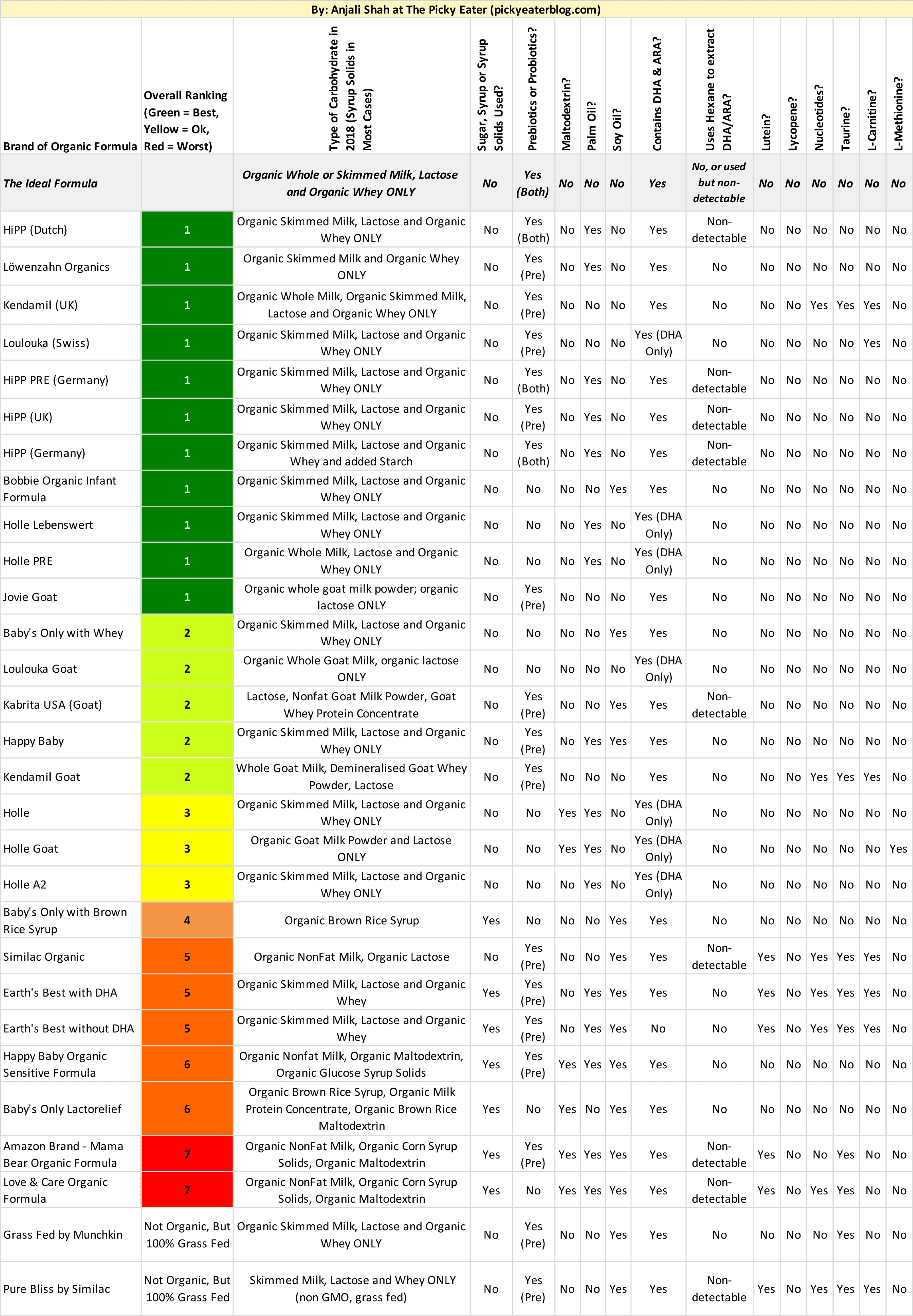

Note: Regarding GrassFed and PureBliss – while they are popular formula brands, they are not part of my best organic baby formulas list (since they are not technically organic). But they are non-GMO and antibiotic-free, and their ingredients list is relatively clean, so I would say they are better than all of the non-organic formulas available in the US today.
Baby Formula Supplements: The Best Vitamin D, DHA, And Probiotics For Babies
Recommendations on Supplementing: DHA, Vitamin D, Probiotics For Infants and Babies
I have gotten a lot of questions about what to supplement with if your baby is on a formula that doesn’t have DHA added, what probiotic to use, or what to do if your baby is getting some breast milk along with their formula (in which case you need to add Vitamin D). Note: In 2022, the EU released new standards for DHA in baby formula and all of the EU formulas are now adhering to those standards. (Source).
If you are looking for additional supplementation for DHA, Vitamin D, and/or Probiotics, here are our top picks for baby supplements:
Best Vitamin D Supplement For Babies
Bobbie Vitamin D Drops is my top pick for vitamin D drops for babies and toddlers. They’re USDA organic certified, vegan, and there is literally nothing added to them (no flavors, colors, etc.). Additionally they are 3rd party tested, Clean Label Certified and were granted the Pesticide Free Award. All you need is 3 drops per day for your baby.
Another good option is Raise Them Well (keep in mind this supplement also contains Vitamin K). Lastly, I also like Baby Vitamin D Drops (which doesn’t contain Vitamin K). These are also liquid and you only need one drop in your baby’s bottle per day. You can also just apply the drop on your baby’s pacifier, on your nipple (if you’re nursing), or on your finger and have your baby suck it off. Super easy, tasteless, and pure. (Read more on why Vitamin D is important for babies).
Best DHA Supplement For Babies
The only Omega 3 supplement I’d recommend for kids is Nordic Naturals. They have an infant DHA supplement and a children’s DHA supplement – both of which are extremely pure, have no added preservatives or sugar, contain Vitamin D in addition to DHA, and are in liquid form so they can be added to just about anything!
Best Probiotics For Babies
Bobbie Probiotic Drops is one of my favorites for babies. These liquid probiotic drops can be used for infants (age 0-12 months) as well as kids, and includes 1 billion live cultures with two strains of probiotics. They’re virtually tasteless and can be mixed into just about anything. Not only that, they’re designed to help with colic and excessive crying, are organic, 3rd party tested, Clean Label Certified and were granted the Pesticide Free Award.
Other great options I like include: Garden of Life’s line of probiotics – they have one for babies, and one for kids. They are shipped cold and their kids one can be added to your baby’s bottle starting at 1 year of age and can be used even when your child gets older (just add the powder to their milk).
For older kids, Garden of Life also has a kids’ chewable probiotic if you need an option that doesn’t require refrigeration. They are a fantastic brand. In fact, I take their adult capsule daily.
Two other options I’d recommend are Klaire Labs’ powdered probiotic, and BioGaia’s probiotic for infants 0-3 months of age. For older kids, see this guide for the best probiotics for kids.
Best Prebiotics For Babies
There is only one prebiotic I’ve found that’s safe for toddlers age 1+ and has super high-quality ingredients and no stabilizers or artificial flavors/colors added. I recommend BeginHealth if you are looking to supplement with a prebiotic for your child. I haven’t found a prebiotic supplement for babies age 0-1. (Learn More: Begin Health Review).
How To Choose The Best Baby Food
For those of you transitioning to solids and looking for homemade baby food recipes, I have a bunch of easy recipes you can try here! But in those instances when you’re on the go and looking for a healthy, organic, pre-made option, my list of the healthiest baby food pouches should help.
Where Can You Buy The Best European Baby Formula In The US?
If you want to buy HiPP, Lebenswert, or Holle online, I have found a few online retailers who are either based in the US or ship reliably to the US! I’m in personal contact with the owners of all of these companie and I feel comfortable recommending all of them to you.
1. The Milky Box
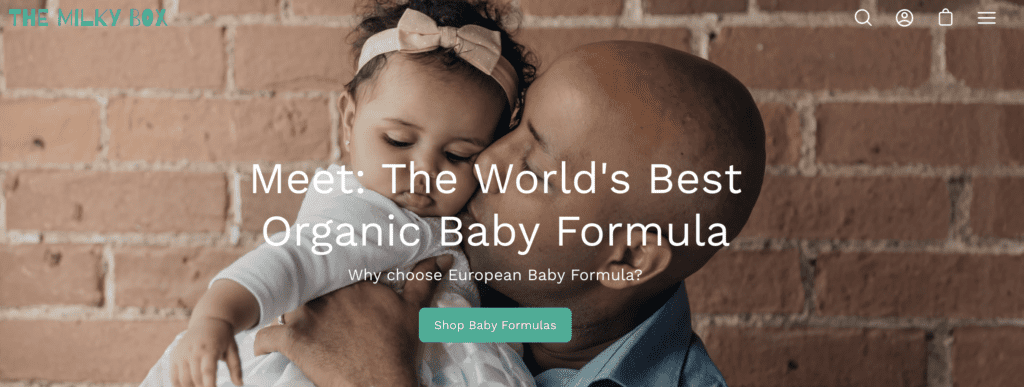

The Milky Box is the only online retailer I’ve found that literally has every European formula you can think of. They are dedicated to ensuring that organic European formulas are available to any parents who want them in the US! Their supply chain is so robust they virtually guarantee that they are always in stock of HiPP Dutch, HiPP UK, HiPP Germany, Holle, Lebenswert, Goat milk formula, and sensitive formulas (HiPP HA, Comfort, Anti-Reflux).
And, they even carry more specialty formulas like Jovie Goat Milk, HiPP Goat Milk, Stage 3 and Stage 4 formula from HiPP, Holle, Jovie, Kendamil, Lebenswert, Kabrita, Nannycare, Premibio, and organic vegan baby formulas like Bebe M!
What Makes The Milky Box Stand Out?
- Guaranteed availability of ALL the European formulas
- They offer one of the largest varieties that is also the most expansive. They carry stages up until 2 years old, so that moms have the option to continue offering high-quality milk to their toddlers.
- They have multiple warehouses across the world, including in Europe and North America, to ensure your formula gets to you ASAP.
- A reputable supplier of Kendamil (one of two suppliers) & the only supplier of Jovie Formulas
- Free standard shipping on all 6, 8, & 12 pack orders!
- A comprehensive mixing guide for every formula listed on their website in case customers lose their instructions.
- A subscribe & save option (up to 5%) with delivery every 1-2 months. And, you can buy bundles to save more!
- Amazing customer support (turnaround within 24 hours)
- Receive an additional 10% off using the code “PICKY10” at checkout!
You can read more about The Milky Box’s story here!
2. Organic’s Best
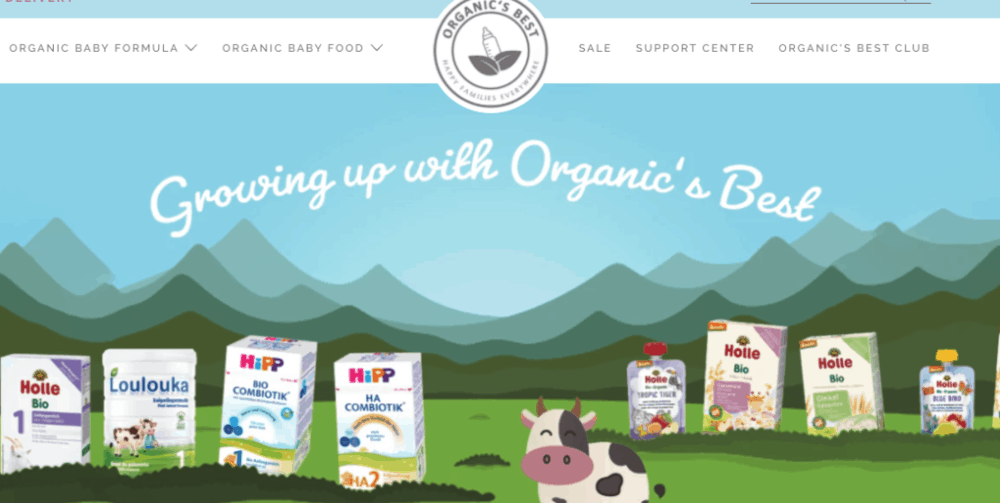

Organic’s Best is based in Germany and is passionate about making organic baby formula and baby food available internationally (to any family who wants it!) They carry the top organic formula options like HiPP Dutch, HiPP Germany, HiPP UK, Holle, Lebenswert, and Loulouka. They also carry HiPP HA, HiPP Comfort, and HiPP AR.
One thing that makes this company unique is that they have free shipping for all orders over $25 and they will guarantee express delivery between 1-4 business days to the US. Additionally, every new customer also receives two free boxes of formula! They have low prices, they include free shipping insurance for every order, and they guarantee the availability of all formulas – so you never have to worry about your favorites being out of stock!
3. Baby Milk Bar
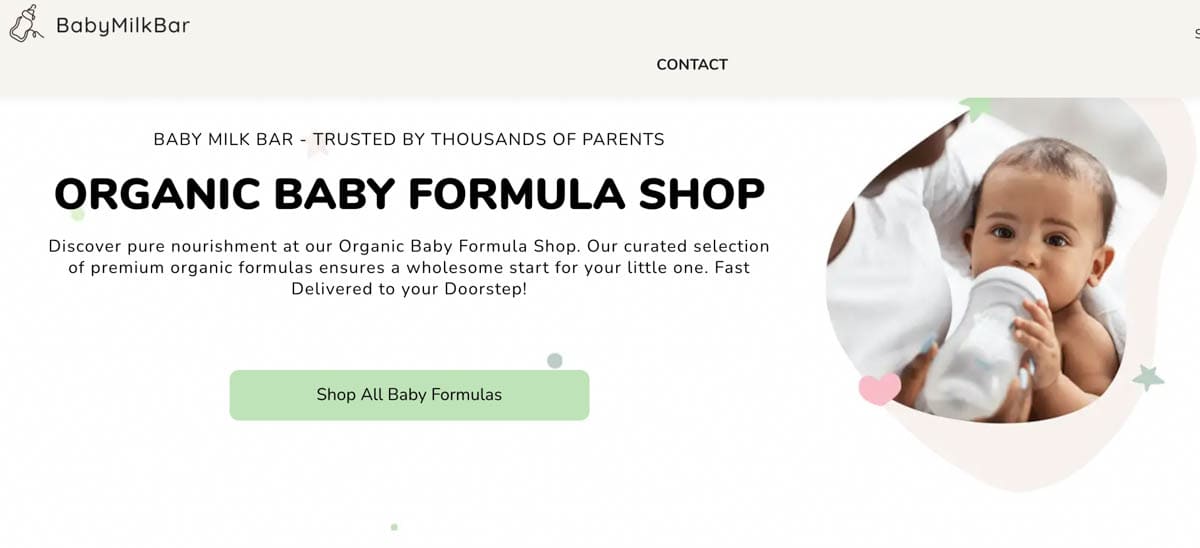

Baby Milk Bar is a family run business based in Europe. They carry some of the widest selection of organic baby formula you will find! Each blend is handpicked by their team to ensure high quality formula to suit every baby’s needs.
They are committed to organic farming, so they carefully choose their manufacturers to ensure all of their formulas satisfy European and organic regulations.
They carry every brand you might want like HiPP Dutch, HiPP German, Lebenswert, Holle and Holle Goat milk formulas. They also carry HiPP HA & HiPP Comfort, among others. And they offer FREE shipping to the US and Canada for any orders over $100!
4. Bottles & Burps


When it comes to affordability, Bottles & Burps is the lowest-priced US retailer I have found that sells some of the best organic formulas for babies like HiPP, Holle, Lebenswert and Kendamil. They can get all of these products to most US households in 5 days from their warehouses.
If you’re looking to save even more, you can order bundles direct from their warehouse in Germany (with free, express 2-5 day shipping to the US). Express shipping from Europe is important because the alternatives can take upwards of 30 days, often suffering additional customs delays.
They are committed to bringing high-quality, European formula to parents in the US at an attractive price. You can also get 20% off any single pack using the code PICKYEATER20 when shopping at Bottles and Burps! Just enter it manually in the checkout process!
5. Organic Formula Shop
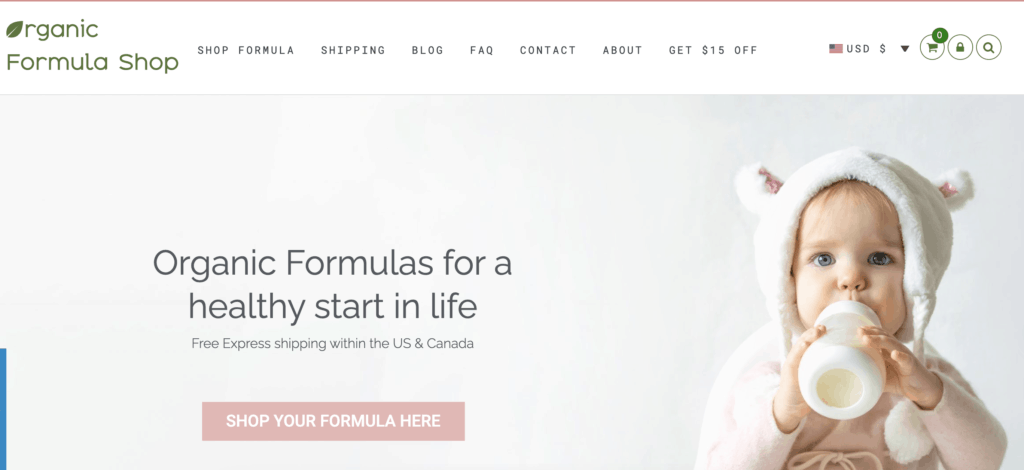

Organic Formula Shop is a solid company that offers a reliable and convenient shopping solution for HiPP, Holle, and Lebenswert anywhere in the United States. Based in the Netherlands, their mission is to share their gathered knowledge about European Formulas with parents and caretakers globally via their website and excellent 24/7 customer support. They also recently launched a new online store for the Indian market.
They carry some of the best baby formula brands like HiPP Dutch, HiPP German, Holle and Holle Goat’s milk formulas. They also carry the sensitive formulas HiPP HA & HiPP Comfort.
Some things that make this company unique: no matter your order size, all orders are delivered for free via Express Shipping within 3 to 5 business days. If the formula you order doesn’t work for your baby, Organic Formula Shop will work with you to find the right option immediately. They are one of the lowest-priced sellers out there and allow bulk purchasing with a 20% discount. Lastly, they even offer a Single Parent Scholarship designed to support a single mother or father with their college or graduate education! I would highly recommend them as a reputable place to order your HiPP and Holle formulas.
6. Organic Baby Food
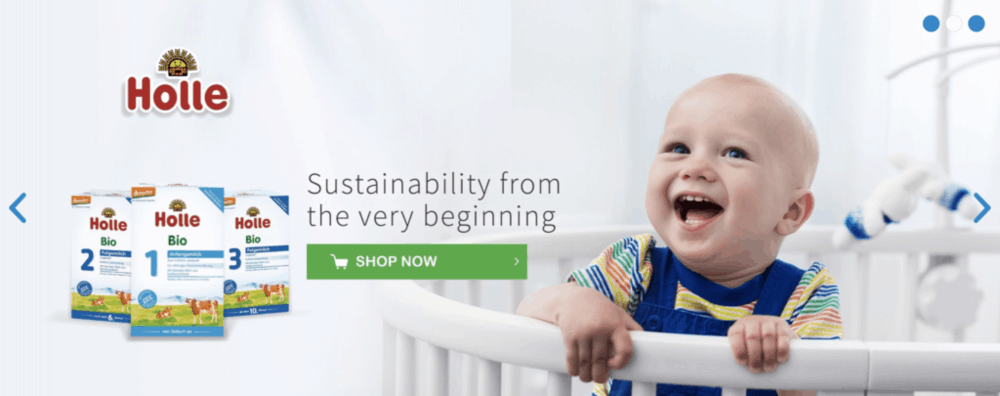

Organic Baby Food is a reputable, online retailer based in the EU that has fast shipping to the US! They have the best organic formula brands like HiPP, Lebenswert, and Holle, along with Hypoallergenic formula and Goat’s Milk formula. They have reasonable prices, reliable shipping (within 1-3 business days!), amazing customer support, and I have been in contact with the owner personally.
In addition to baby formula, they also have a variety of organic cereals and snacks for babies from HiPP/Holle/Leb, as well as a line of baby care products (shampoo, lotion, calendula) that are gentle and free of any synthetic ingredients so they are perfect for babies!
A few other great things about this company: guaranteed delivery within 2 days, money back if your shipment is delayed, dedicated customer support (a few hours turnaround time for emails or direct phone support at 1-800-701-4303), and deep discounts up to 60% off sometimes! They are also giving readers of The Picky Eater a 10% off coupon code at checkout – just use the code: PICKY and you will get the discount!
Baby Formula FAQs
Any formula that has a 60:40 whey to casein ratio, and contains the key vitamins and minerals necessary for infant development are very close to breast milk. HiPP Dutch, Bobbie Formula, Kendamil Formula, Holle, and Lebenswert are all close to breast milk.
Some US brands like Enfamil claim that they have the formula closest to breast milk because they include proteins found in colostrum, like lactoferrin, however, Enfamil is not organic so I wouldn’t choose that brand over the others listed above just for the lactoferrin.
There are many options in this guide for the healthiest baby formula! We would rank HiPP, Kendamil, Bobbie, Holle, and Lebenswert all at the top of the list of the healthiest and best baby formula options.
Organic formulas tend to be better compared to conventional formulas because they are free from antibiotics, chemical fertilizers, hormones, and more.
However, not all families may be able to choose organic formula. Other considerations such as price, or needing a hypoallergenic formula (which by definition will not be organic due to the hydrolyzed proteins), or availability should also be kept in mind when choosing a formula.
According to the CDC, most baby formulas need to be used within 1 month of opening the container. Unopened formula can be good for up to 6-12 months (use the expiration date on the container to determine how long your formula is good for).
Theoretically yes, but this can be tricky depending on which formulas you’re trying to mix. If you want to mix formulas, consult your pediatrician first to make sure you’re following the correct standard mixing instructions. You might want to mix formulas if you either feel like your baby does well with a mix of two formulas, or if you are trying to slowly transition from one formula to another.
Here are some steps to help you make an informed choice when deciding which is the right formula for your baby:
1) Talk to your pediatrician first – they can provide recommendations based on your baby’s specific needs.
2) Determine the type of formula – cow’s milk, goat’s milk, hypoallergenic, vegan, etc. based on your baby’s age and any allergies or dietary restrictions.
3) Consider the ingredients list and choose formulas that have no sugar or syrup solids added, are non GMO, and meet your baby’s nutritional requirements.
4) Consider cost & budget! Always choose a formula that meets your budget constraints.
Final Thoughts
Not every baby likes every formula. Some formulas constipate or irritate some babies, yet keep other babies’ tummies perfectly happy. If you try the formulas I recommend and they don’t work for your baby – that is ok!
There is no perfect formula, but some are still much better than others. If you can afford it, the best organic baby formulas are HiPP, Lebenswert, and Holle – so I’d recommend shipping your formula from Europe whenever possible.
Organic infant formulas are more expensive than regular formula, and not every parent has the financial means to buy organic formula for their little ones – and that’s ok, too! Just do the best you can for your baby.
Overall, I advocate a world of no judgments when it comes to breastfeeding or formula feeding. All you can do as a mom is your best. Whether you breastfeed for a year, or 6 months or 1 month, or 0 months doesn’t make you a better or worse mother. A happy healthy mom and happy healthy baby is all that matters.
I hope this post helped you find the right baby formula for you and your little one!
Appendix: More Info on Hexane Extracted DHA/ARA in Formula
I spoke with an expert who has her BS in Biology with a minor in Chemistry, who worked in an organic chemistry lab for 2 years and worked with many solvents used in extractions, compound purification, and analysis, and then went on to get an MS in Biochemistry and Molecular Biology. She is extremely knowledgable when it comes to hexane and extraction methods, so I asked her for her thoughts on how concerned we should be about hexane-extracted DHA/ARA in the best organic baby formulas on this list. Here is the summary:
- Hexane is often used as extraction solvent for extracting fats. This is because it has a low boiling point when compared to most fats, which makes it easy to get rid of post-extraction – leaving the fat behind.
- To get rid of Hexane, chemists use a large apparatus called a “rotary vap” that gets rid of the solvents and you end up with a pure powder substance (usually a chemical compound). The next step is to check the purity of the compound using a machine called an NMR or MS, which tells you whether you have any of your solvent left.
- This woman told me that she never, ever found an issue with having hexane still present after drying her sample.
- Since formulas are a powder, they are heated to the point of water removal, and therefore the hexane should be all gone. It is unlikely that hexane is left in properly treated formula, but you are placing trust in the formula and manufacturing industry that all formula is being properly prepared.
- Note: All oils that don’t have a cold-pressed process are extracted using hexane – this includes corn oil, soy oil, vegetable oil, etc. (unless otherwise specified on the bottle). Hexane is also used during the development process for drugs – many drugs are purified in a hexane solvent and then it is dried off. So if you are going to question hexane, you need to be aware of the other areas where it is used in our regular food and drug supply!
- When it comes to being concerned about hexane vs. other questionable ingredients in organic formulas – maltodextrin, soy oil, etc., I’d be more concerned about maltodextrin vs. hexane extracted DHA. This is because maltodextrin’s glycemic index is much higher than table sugar and I personally believe a lot of issues today come from sugar and inflammation, and even when hexane is used it should be gone by the time the formula is packaged.
- Unfortunately, there is no formula out there that doesn’t have at least one of the “offending” ingredients in formula milk that I have listed above! For me personally, I would choose hexane-extracted DHA over maltodextrin or soy oil for example. This is because soy oil is also extracted using hexane, and maltodextrin has an extremely high glycemic index. In addition, formulas that contain soy oil or maltodextrin are 100% guaranteed to contain these ingredients, versus hexane which is likely not traceable in a formula that has used it as a method to extract DHA/ARA before the formula has been prepared!
Health
Colon Cancer Rates Are Rising in Young Americans, but Insurance Barriers Are Making Screening Harder

More than 53,000 Americans are projected to die from colorectal cancer this year. Although colorectal cancer is the second-most common cause of cancer deaths in the United States, it can be cured if caught early. Detecting a tumor as soon as possible can help you get treatment as soon as possible, giving you the best chance for survival.
In my work as a gastroenterologist, I treat patients from every background and walk of life. Uniting them are a growing number of insurance barriers threatening access to timely care. All too often, payers take a long time to make coverage determinations, or they even deny them outright.
With the alarming rise of colorectal cancer diagnoses among Americans under 50, it is more important than ever for people to know their cancer risk and when to get screened.
Here are common questions I and other gastroenterologists get from patients about colorectal cancer:
What is my colorectal cancer risk?
Anybody at any age can develop colorectal cancer. However, some people may be more likely to get the disease than others.
For example, people with a family history of colorectal cancer or a personal history of polyps, which are abnormal growths in the tissue of the colon or rectum, may have a higher risk.
Inflammatory bowel diseases like Crohn’s and ulcerative colitis can also increase your risk of developing colorectal cancer. This is because the chronic inflammation associated with these diseases can promote the development of abnormal growths.
Race and ethnicity may also affect colon cancer risk. Black and Indigenous Americans are significantly more likely to develop – and die from – colorectal cancer. While genetics does play a role in disease development, much of the risk of colorectal cancer is linked to environmental factors. These include a person’s income level, types of food and groceries available in the neighborhood, access to primary care providers and specialists, and a wide variety of other social determinants of health.
Lifestyle factors like smoking, not exercising regularly and poor diet can also increase your colon cancer risk. Researchers have shown that red meat releases chemicals that can cause inflammation, while high-fiber foods and vegetables can help lower inflammation. Similarly, a sedentary lifestyle can also increase inflammation. Smoking can lead to harmful genetic changes in colon cells.
What are my screening options?
People with colorectal cancer usually don’t exhibit symptoms until the disease progresses to a later stage. That is why early and regular screening is critical.
The U.S. Preventive Services Task Force recommends Americans begin regular screenings at age 45. Recognizing that the incidence of colorectal cancer has grown among younger adults, the task force lowered the age from 50 in 2021. Screening may start earlier and occur more frequently for people who have an increased risk of colon cancer.
There are various screening methods, and your medical provider can recommend procedures based on your risk factors.
Many people choose to get a colonoscopy, which is a screening test that can also prevent cancer by removing precancerous polyps. It involves using a long, flexible tube with a light and a camera on the end to visually inspect the colon for signs of cancer, abnormalities in the colon lining, or growths such as polyps. Ultimately, colonoscopy screening can significantly reduce the incidence and mortality of colorectal cancer.
Other screening strategies include noninvasive stool testing, imaging scans and a combination of endoscopic visualization with stool-based testing.
Your doctor can help you select a test that aligns with your preferences, values and risk factors. Suggested screening approaches in people with an average colon cancer risk include a colonoscopy every 10 years, stool-based testing every one to three years, or CT scans every five years for those who are unable to have a colonoscopy as an initial screening test. A positive test result for these alternative approaches should be followed by a colonoscopy.
With routine screening, one out of every three colorectal cancer deaths can be avoided.
Why won’t my health insurance pay for my colonoscopy?
While colorectal cancer screening is free as a preventive service under the Affordable Care Act, some insurers are making it harder for people to get care.
For example, Blue Cross Blue Shield of Massachusetts proposed a 2024 policy that would have deemed the use of anesthesia in endoscopies, colonoscopies and other vital procedure as medically unnecessary. This meant patients would have had to pay out of pocket to cover the anesthesia needed for colorectal cancer screenings, potentially creating major cost barriers. The insurance company only reversed course after an outcry from physicians and patients.
Another troubling trend is expanded use of prior authorization, a process some health insurers use to determine if they will cover the cost of a medical procedure, service or medication. Insurers can delay or deny coverage of medically necessary care that physicians and medical guidelines recommend because they deem certain health care services unnecessary for a patient or too expensive to cover.
In 2023, UnitedHealthcare proposed a policy that would have required the 27 million people under their plan to obtain insurance approval before they could get diagnostic or follow-up colonoscopies. After protests from physicians and patients, the insurer put the policy on hold.
UnitedHealthcare has also made plans to introduce a program in 2024 that could involve prior authorization for colonoscopies. The insurer has released little information about why it feels such requirements are necessary, what services would require prior authorization and how it would protect patients from unnecessary delays and denials.
How can I lower my risk of colorectal cancer?
If you haven’t already, look into getting screened for colorectal cancer. Talk with your doctor’s office and check with your insurance company to understand what will be covered before your procedure. If you’re 45 or older, a colonoscopy can screen for and prevent colorectal cancer.
Younger adults can take steps to reduce their risk of colon cancer by adopting healthy eating and lifestyle behaviors. Being aware of personal risk factors and seeking medical attention for symptoms – such as changes in bowel habits, rectal bleeding, abdominal pain or unexplained weight loss – can help you discuss screening options with your health care provider.
If you have already had a colonoscopy and had polyps removed, make sure you know when you are due to return for a follow-up colonoscopy. It could save your life.![]()
![]()
Andrea Shin, Associate Professor of Medicine, University of California, Los Angeles
This article is republished from The Conversation under a Creative Commons license. Read the original article.
Health
The Future of Men’s Mental Health


Part 5 —Male Menopause: Speaking Out About the Unspeakable Passage
This is the 5th in a series of articles on the Future of Men’s Mental Health. In Part 1, I addressed the questions, “Men and Mental Health, What Are We Missing?” Part 2 focused on the way that “Mental Health Crises Are Putting Everyone at Risk.” In Part 3, I explored Gender-Specific Healing and Man Therapy. In Part 4, I shared Recent Research From Leading Neuroscientists.
The title of the first chapter of my book, Male Menopause, was titled, “Putting the Men Back in Menopause.” I detailed my initial explorations this way:
“When I began researching this book, I was skeptical about the concept of ‘male menopause.’ I had been a therapist for over thirty years and had worked with thousands of midlife men and women. Is there really a change of life that men go through?”
I went on to describe my encounter with one of the earliest proponents of male menopause, the writer Gail Sheehy.
“While browsing through my local bookstore, I was drawn to a copy of Vanity Fair magazine. Well, to be absolutely honest, I was drawn to the cover photo of Sharon Stone, nude to the waist, with her hands cupping, but only partially covering, her breasts. Sharon was staring seductively into the eyes of the reader, with two-inch letters emblazoned across her bare midriff proclaiming, ‘WILD THING!’ I was sure there was something important Sharon had to tell me.”
I went on to say,
“However, I never read the article to find out, because just to the left of Sharon’s blond hair, right below the April 1993 dateline, were the words that grabbed me by the throat (actually a bit farther south than my throat)—‘Male Menopause: The Unspeakable Passage by Gail Sheehy.’ Those words spoke in a quiet but insistent voice.”
Male Menopause was published in 1997 and soon became an international best-seller. It has since been translated into more than fifteen foreign languages. My follow up book, Surviving Male Menopause: A Guide for Women and Men, was published in 2000. There continues to be a great deal of confusion and controversy surrounding the whole concept of what goes on at mid-life for men. As Sheehy recognized in the 1993 article,
“If menopause is the silent passage, ‘male menopause’ is the unspeakable passage. It is fraught with secrecy, shame, and denial. It is much more fundamental than the ending of the fertile period of a woman’s life, because it strikes at the core of what it is to be a man.”
I was one of the early researchers who was speaking out about Male Menopause (also called Andropause or Manopause). Here are a few of the important things I’ve learned over the years and have shared in my books and articles.
What is Male Menopause?
Male Menopause begins with hormonal, physiological, and chemical changes that occur in all men generally between the ages of forty and fifty-five, though it can occur as early as thirty-five or as late as sixty-five. These changes affect all aspects of a man’s life. Male Menopause is, thus, a physical condition with psychological, interpersonal, social, and spiritual dimensions.
What is The Purpose of Male Menopause?
“The purpose of Male Menopause is to signal the end of the first part of a man’s life and prepare him for the second half. Male Menopause is not the beginning of the end, as many fear, but the end of the beginning. It is the passage to the most passionate, powerful, productive, and purposeful time of a man’s life.”
What Are The Most Common Symptoms of Male Menopause?
- Loss of libido and sexual desire, particularly with the partner you are with.
- Increased fantasy about having sex with others.
- Difficulty developing and maintaining erections.
- Increased irritability and anger.
- Taking longer to recover from injuries and illness.
- Having less endurance for physical activity.
- Increased anxiety and worry.
- Loss of self-confidence and joy.
What Are Common Life Changes Associated with Male Menopause?
- Hormone levels are dropping, particularly testosterone.
- Sexual vigor is diminishing.
- Children are leaving.
- Parents are dying.
- Job horizons are narrowing.
- Friends are dying or getting serious illnesses.
- Martha Weinman Lear, writing in the New York Times Magazine summed it up this way.
“The past floods by in a fog of hopes unrealized, opportunities not grasped, women not bedded, potentials not fulfilled, and the future is a confrontation with one’s own mortality.”
Over the years, I have found two common extreme views: (1) Male Menopause doesn’t exist. Only women go through a hormonally driven change of life. (2) If men do go through a change, it is only a hormonal change, and can be “cured” by giving men supplemental testosterone.
I’ve learned that neither of these views are true. Men do experience a change of life, whether we call it Male Menopause, Andropause, or Manopause. I called it Male Menopause because I believe there are more similarities than differences between what women and men experience. I also believe, as does, Gail Sheehy, that it is much more complex than simply a loss of hormones and
“It is much more fundamental than the ending of the fertile period of a woman’s life, because it strikes at the core of what it is to be a man.”
Surviving Male Menopause Together. How Can Couples Navigate the Change of Life?
After Male Menopause was published and become an international best-seller with 15 foreign editions, I received letters from women all over the world asking questions about the relational aspects of what men go through. I wrote the book Surviving Male Menopause: A Guide for Women and Men to answer questions including the following:
- How does male menopause differ from the midlife crisis?
- Why do men have affairs at this time of life?
- What are the best methods for treating erectile dysfunction?
- Why do menopausal men act so much like adolescent boys?
- What can a woman do to help a man get through male menopause?
Is There Anything Good About Male Menopause?
Like so many complex aspects of life, when we try to oversimplify things, we lose the very essence of what we are trying to study. When we deny the reality of a “male change of life” and reduce it to a “midlife crisis” or simply see the change in medical terms, we give men few options.
For most of human existence our lifespan was quite limited to around forty years. Men and women rarely lived long enough to experience a “change of life.” Life was a climb up a mountain and we reached the peak when we were in our 20s and had produced children to keep our species going. Then, it was a quick decline down the mountain once the children were old enough to survive.
But now humans can live into our 80s, 90s, and beyond. Now there is another mountain to climb and what we call Male Menopause is simply the transition to the second mountain. If top of the first mountain is called “Adulthood,” the peak of the second mountain, is “Super-Adulthood” or “Elderhood.” That is why I say that
“Male Menopause is not the beginning of the end, as many fear, but the end of the beginning.”
Too Many Men Are Dying Before Their Time
These are confusing and challenging times for most people, but particularly for men. It has been said that “Old age is not for sissies.” While many men are embracing the later years, too many are losing hope and giving up. The suicide rate for men is much higher than the rate for women and gets even worse the older we get.
Take a look at this chart from the Centers for Disease Control (CDC):
Suicide rate among adults age 55 and older, by age group and sex: United States, 2021

We see the men’s death rates on the left and women’s on the right for four different age groups. It is clear that death by suicide is a huge problem for men as we age. The male/female ratio for ages between 55 and 85+ are almost 5 times higher for males. This is a tragedy and a crisis. Clearly older men are feeling pressures that women do not experience and are losing hope for a better future. This needs to change.
Welcome to the Second Mountain and an Expanded Understanding of Midlife and Aging
My friend and colleague, Chip Conley, is transforming our understanding of midlife and what we can look forward to as we prepare for and climb the second mountain of life. Says Conley, “The midlife crisis is the butt of many jokes, but this long-derided life stage has an upside.” In his new book, Learning to Love Midlife: 12 Reasons Why Life Gets Better with Age, he expands our vision.
“What if we could reframe our thinking about the natural transition of midlife not as a crisis, but as a chrysalis: a time when something profound awakens in us, as we shed our skin, spread our wings, and pollinate the world with our wisdom?“
We know midlife and aging is not all sweetness and light. It isn’t easy letting go of old ways that no longer work for us. We all know what happens to the caterpillar. As Conley reminds us,
“When it is fully grown, it uses a button of silk to fasten its body to a twig and then forms a chrysalis. Within this protective chrysalis, the transformational magic of metamorphosis occurs. While it’s a bit dark, gooey, and solitary, it’s a transition, not a crisis. And, of course, on the other side is a beautiful, winged butterfly.”
You can learn more about Chip’s work and his book on his website, https://chipconley.com/
Learning About Men’s Health, Male Menopause, and How to Live Well in the Second Half of Life
There is a lot we need to learn about life in the second half. Chip Conley suggest that there are three stages of midlife:
- Early midlife (Age 35-50)
During early midlife we tend to experience some of the challenging physical and emotional transitions—a bit like an adult puberty. We realize we are no longer young, but not yet old.
- The second stage of midlife (50-59)
This is the core of midlife in our fifties when we’ve settled into this new era and are seeing some of the upside. We begin to see opportunities for growth and finding passions we never knew we had.
We are still young enough to see and plan for what’s next, our senior years. Says Chip,
“At 63, I am just getting acquainted with this third stage, but I do know it’s also when our body reminds us it doesn’t want to be forgotten.”
I turned 80 last December and am well into the stage of Eldership. It’s a time where we are called to share what we know and have learned over our lifespan. Three years ago I started the MenAlive Academy for Gender-Specific Healthcare. The Academy offer programs for both men and women who want to learn about the unique mental, emotional, and relational issues that men face. It also offers programs for healthcare providers who are working with men and their families.
As my colleague Marianne J. Legato, M.D., Founder of the Foundation for Gender-Specific Medicine says,
“Everywhere we look, the two sexes are startingly and unexpectedly different not only in their normal function but in the ways they experience illness.”
If you would like more information about the MenAlive Academy for Gender-Specific Healthcare, drop me a note to Jed@MenAlive.com and put “MenAlive Academy” in the subject line. If you’d like to read more articles like these, I invite you to subscribe to our free weekly newsletter.
Health
Longevity Cheat Sheet: 15 Ways to Live Longer

#1: Do not smoke cigarettes
- Benefit: +66%
- Scientific Rigor: 3/3
The most boring and yet most effective recommendation on the list shouldn’t surprise anyone. Don’t light toxic stuff on fire and then inhale it. Never-smokers vs. lifelong smokers have a whopping 66% reduction in mortality by age 79, and quitting after a long time of smoking can also retain much of this benefit.
#2: Take 8,000 to 12,000 steps per day
- Benefit: +51%
- Scientific Rigor: 2/3
There’s a reason fitness trackers target 10,000 steps per day: It’s the magic number that gets you most of the possible improvement. Increasing step count from 4,000 to 8,000 per day was associated with a staggering 51% reduction in death from all causes (all-cause mortality). Additionally, the intensity of the steps, like running vs. walking, didn’t matter at all. So 25 minutes on the elliptical might save you time in obtaining your step goal, but each step will benefit your longevity the same as a normal walk.
#3: Get sufficient sunlight
- Benefit: +50%
- Scientific Rigor: 1/3
This was higher up the list than expected, but it turns out that totally hiding from the sun might really hurt you. A study of 29,518 Swedish women found a 2X decrease in mortality associated with the highest amount of sun exposure. Note that we only gave this study a scientific rigor score of 1/3 because it was only women and took place in a northern climate. The correlation with sunbathing was seen in a country with a very low UV index, which should be interpreted with caution. However, many other studies have found that adequate sunlight is important for longevity, often related to Vitamin D and melatonin.
It’s obvious, but worth stating anyway: Too much sun can kill you. So don’t take this as advice to sit in the sun all day or to get sunburnt.
#4: Consider dry sauna a few times per week
- Benefit: +40%
- Scientific Rigor: 1/3
The study showcasing sauna benefits is from Finland, as many sauna aficionados might have guessed. The study only includes men and they’re all from Finland, but it’s the best study Guava Health found and it shows a substantial 40% reduction in all-cause mortality for those who used a sauna 4-7 times per week compared with once per week. Normally the study would include comparisons with zero saunas per week, but apparently that is unheard of in the sauna capital of the world. Keep in mind this is for dry saunas at around 175 degrees F, so does not necessarily apply to cooler saunas, infrared saunas, or steam rooms. However, a study linking infrared sauna with coronary improvements was found.
#5: Brush and floss your teeth nightly
- Benefit: +37%
- Scientific Rigor: 2/3
In addition to not aggravating the people within smelling distance, brushing and flossing each independently help you live longer, according to Guava Health’s chosen study on dental behaviors, conducted on adults 52 and older. Brushing and flossing every day compared to not every day was associated with a mighty 37% reduction in death during the study period. Yep, it wasn’t just something your parents bugged you about; it might actually kill you. A curious discovery in the article was that nightly brushing was most important, and was even better than morning and daytime combined. Flossing every day was best, but don’t worry if you’re lazy sometimes, there was still a noticeable benefit in flossing “sometimes,” just not as much.
#6: Minimize your stress levels
- Benefit: +34%
- Scientific Rigor: 2/3
Another commonly mentioned factor of faster aging, reduction of perceived stress, landed on the list with thorough scientific evidence. There is an entire industry around stress reduction, but if you’re looking to improve, you should first consider all the other health improvements on this list since many can reduce stress. Then, perhaps consider meditation or massage, which both have scientific evidence of stress reduction.
#7: If you drink alcohol, stay below 7 standard drinks per week
- Benefit: +31%
- Scientific Rigor: 3/3
A small amount of alcohol appears to give you slight protection from a few causes of death, notably myocardial infarction, but it’s still detrimental to overall longevity. For amounts below 100 grams (~7 drinks) per week, this study of 599,912 people found negligible effects on mortality. But, as you can see in the chart, those negative effects increased steeply above 7 drinks per week. Cutting down from 3 drinks per day to 1 drink could reduce your risk of death by 31%.
Keep in mind that if you don’t currently drink, it’s not recommended you start, since alcohol is known to be addictive and moderating your consumption might be difficult.
#8: Consider intermittent fasting
- Benefit: +26%
- Scientific Rigor: 1/3
Caloric restriction is one of the most effective and persistent methods of extending life across every species of life ever studied. Humans, however, have not been equally proven to live longer simply by reducing calories. There are some studies showing probable positive effects, such as the people who eat less in the Japanese islands of Okinawa, and across studies of fasting, which is a little different from calorie restriction. The best study Guava Health found wasn’t as thorough as hoped because it studied only 2,714 people and they were all recovering from a surgical procedure. But, it did show a very substantial reduction in mortality for those who routinely fasted for 5+ years compared with those who didn’t fast.
#9: Don’t consume too much sugar
- Benefit: +23%
- Scientific Rigor: 2/3
This study found that consuming only 10% of your daily calories as sugars compared with 20% or more offered a 23% reduction in mortality. The authors also found that it was more helpful to reduce sugar in beverages than it was in solid foods. Similar to avoiding excess sugar, avoiding high glycemic index foods can also be helpful to your longevity. Basically, eat more of the stuff like nuts and vegetables that don’t give you an instant dump of energy.
#10: Minimize processed meat
- Benefit: +19%
- Scientific Rigor: 3/3
Of all the meats you can eat, fish is one of the best for longevity, while red meat and processed meat are among the worst. That’s a generalization, of course — some fish are much healthier to eat than others (wild salmon is great), and the quality of red meats can vary significantly. The study Guava Health chose shows the biggest offender to be processed meat by far, but also indicates red meat is slightly harmful on average. So the official recommendation here is to avoid processed meat when you can, and either avoid red meat or be sure it’s high quality.
#11: Avoid bad air quality
- Benefit: +17%
- Scientific Rigor: 3/3
Bad air can come from many sources, including polluted cities, factories, forest fires, and high-heat cooking. Basically, it’s not healthy to burn stuff and then breathe it in. A massive study on U.S. cities found that each 10 µg/m3 decrease in PM2.5, a common measure of air pollution, reduces your mortality by 17%. This amount of reduction or more could be achieved by moving from a polluted city or factory to the suburbs. You can easily find your neighborhood’s current PM2.5 measurement online. If you’re in one of the world’s most polluted cities, your potential benefit could be much higher than 17%. And if you don’t plan on moving, you can also use an air purifier in your home and office, and use a car with HEPA filters to help minimize your exposure.
#12: Consider drinking coffee — even decaf
- Benefit: +15%
- Scientific Rigor: 3/3
Before modern science began adjusting for confounding factors, researchers used to think that coffee increased death rates. In reality, coffee drinkers were just more likely to also smoke cigarettes. After adjusting for this, recent studies show a non-trivial reduction in mortality for moderate coffee drinking of 2-4 cups per day. Furthermore, the improvement appears to remain even if you’re a slow metabolizer of caffeine, which is something you can test for with popular genetic test kits. Note that it’s coffee studied here, not caffeine. Decaffeinated coffee has shown similar results.
Remember, caffeine is a drug and is often addictive. It can be beneficial, but can also cause serious effects on your body, particularly at high amounts, so consult your doctor if you’re unsure.
#13: Eat 5 servings of fruits and vegetables per day
- Benefit: +13%
- Scientific Rigor: 2/3
More servings of fruits and veggies were associated with lower mortality, plateauing around ~5 servings. Notably, this does not include starchy veggies like corn, peas, and potatoes, nor does it include fruit juices. Increasing from 2 to 5 servings per day is what showed the 13% benefit being highlighted.
#14: Sleep 7-9 hours per night
- Benefit: +11%
- Scientific Rigor: 3/3
Many studies, including this meta-study, show increased mortality if you sleep too little. One difficulty is they had to combine different definitions of “short sleep” ranging from 4 to 7 hours, but the overall result was that staying above ~7 hours reduced mortality. A curious result of their study was that long sleep was even worse than short sleep. Somewhere in the range of 7-9 hours looked optimal for most studies, and although the studies were based on survey answers and couldn’t measure it, it’s common to recommend 7 hours of time actually asleep and not just laying in bed.
#15: Consider metformin
- Benefit: +7%
- Scientific Rigor: 3/3
Normally a drug targeting a specific disease would not be included in a longevity cheat sheet built for everyone, but metformin is a notable exception. In studies meant to understand its effectiveness at improving diabetes, the researchers were surprised to find that metformin reduced death from all causes for diabetics, even beyond non-diabetics, by 7%. This suggests that non-diabetics could benefit by even more than 7% by taking it. However, metformin is a prescription drug in the U.S., so Guava Health only recommends considering it through talking with your doctor, or other legitimate pathways if you live outside the U.S.
Bonus: Drinking more water doesn’t seem to help
- Benefit: +0%
- Scientific Rigor: 1/3
Strangely, no correlation was found between the amount of liquids consumed in a day and mortality. We all know that you’ll die within days if you stop drinking water, but perhaps the negative effects only appear with extreme dehydration, whereas all the study participants had full access to water.
This story was produced by Guava Health and reviewed and distributed by Stacker Media.
-

 African History5 years ago
African History5 years agoA Closer Look: Afro-Mexicans 🇲🇽
-

 African History5 months ago
African History5 months agoBlack History Facts I had to Learn on My Own pt.6 📜
-

 African History5 years ago
African History5 years agoA Closer Look: Afro-Mexicans 🇲🇽
-

 African History1 year ago
African History1 year agoMajor African Tribes taken away during the Atlantic Slave Trade🌍 #slavetrade #africanamericanhistory
-

 African History1 year ago
African History1 year agoCameroon 🇨🇲 World Cup History (1962-2022) #football #realmadrid #shorts
-

 African History5 months ago
African History5 months agoBlack History Inventors: Mary Kenner 🩸
-

 African History1 year ago
African History1 year agoPROOF AFRICAN AMERICANS AIN'T FROM AFRICA DOCUMENTED EVIDENCE
-

 African History1 year ago
African History1 year agoNo African pre-Columbus DNA? 🤯🤯 #history #mesoamerica #mexico #african

